
Color Laser Printer
User???s Guide
imagine the possibilities
Thank you for purchasing a Samsung product. To receive a more complete service, please register your product at

Color Laser Printer
User???s Guide
imagine the possibilities
Thank you for purchasing a Samsung product. To receive a more complete service, please register your product at

features of your new laser product
Your new machine is equipped with a number of special features that improve the quality of the documents you print. With the machine, you can:
SPECIAL FEATURES
Print with excellent quality and speed
???You can print in a full range of colors using cyan, magenta,
yellow, and black.
??? You can print with a resolution of up to 2400 x 600 dpi Effective output.
???Your machine prints
Handle many different types of printable material
???The
Create professional documents
??? Print watermarks. You can customize your documents with words, such as ???Confidential???. See Software section.
??? Print posters. The text and pictures of each page of your document are magnified and printed across the sheet of paper and can then be taped together to form a poster. See
Software section.
???You can use preprinted forms and letterhead with plain paper. See Software section.
Save time and money
??? To save paper, you can print multiple pages on one single sheet of paper.
??? This machine automatically conserves electricity by substantially reducing power consumption when not in use.
.
Print in various environments
???You can print with Windows 2000 and Windows XP/2003/
Vista as well as Linux and Macintosh systems.
???Your machine is equipped with a USB interface and a network interface
2_Features of your new laser product

FEATURES BY MODELS
The machine is designed to support all of your document needs ??? from printing, to more advanced networking solutions for your business. Basic features of this machine include;
USB 2.0
Network Interface 802.11b/g wireless LAN
Network Interface Enthernet 10/100 Base TX wired LAN
Duplex
( : Included, O: Optional, Blank: Not Available)
ABOUT THIS USER???S GUIDE
This user???s guide provides information about basic understanding of the machine as well as detailed explanation on each step during the actual usage. Both novice users and professional users can refer to this guide for installing and using the machine.
Some terms in this guide are used interchangeably, as below:
???Document is synonymous with original.
???Paper is synonymous with media, or print media. Following table offers the conventions of this guide:
Features of your new laser product_3

FINDING MORE INFORMATION
You can find information for setting up and using your machine from the following resources, either as a
Quick Install Guide Provides information on setting up your machine and this requires that you follow the instructions in the guide to prepare the machine.
Online User???s Guide Provides you with
This user???s guide also contains a Software section to provide you with information on how to print documents with your machine in various operating systems, and how to use the included software utilities.
Note
You can access the user???s guide in other languages from the Manual folder on the printer software CD.
Printer Driver Help Provides you with help information on printer driver properties and instructions for setting up the properties for printing. To access a printer driver help screen, click Help from the printer properties dialog box.
Samsung website If you have Internet access, you can get help, support, printer drivers, manuals, and order information from the Samsung website, www.samsungprinter.com.
4_Features of your new laser product

safety information
IMPORTANT SAFETY SYMBOLS AND PRECAUTIONS
What the icons and signs in this user???s guide mean:
Hazards or unsafe practices that may result in severe personal injury or death.
WARNING
CAUTION
CAUTION
Hazards or unsafe practices that may result in minor personal injury or property damage.
To reduce the risk of fire, explosion, electric shock, or personal injury when using your laser MFP, follow these basic safety precautions:
Do NOT attempt.
Do NOT disassemble.
Do NOT touch.
Follow directions explicitly.
Unplug the power plug from the wall socket.
Make sure the MFP is grounded to prevent electric shock.
Call the service center for help.
These warning signs are here to prevent injury to you and others. Follow them explicitly. After reading this section, keep it in a safe place for future reference.
1.Read and understand all instructions.
2.Use common sense whenever operating electrical appliances.
3.Follow all warnings and instructions marked on the machine and in the literature accompanying the machine.
4.If an operating instruction appears to conflict with safety information, heed the safety information. You may have misunderstood the operating instruction. If you cannot resolve the conflict, contact your sales or service representative for assistance.
5.Unplug the machine from the AC wall socket and/or telephone jack before cleaning. Do not use liquid or aerosol cleaners. Use only a damp cloth for cleaning.
6.Do not place the machine on an unstable cart, stand or table. It may fall, causing serious damage.
7.Your machine should never be placed on, near or over a radiator, heater, air conditioner or ventilation duct.
8.Do not allow anything to rest on the power. Do not locate your machine where the cords will be abused by persons walking on them.
9.Do not overload wall outlets and extension cords. This can diminish performance, and may result in the risk of fire or electric shock.
10. Do not allow pets to chew on the AC power, telephone or PC interface cords.
11.Never push objects of any kind into the machine through case or cabinet openings. They may touch dangerous voltage points, creating a risk of fire or shock. Never spill liquid of any kind onto or into the machine.
12. To reduce the risk of electric shock, do not disassemble the machine. Take it to a qualified service technician when repair work is required. Opening or removing covers may expose you to dangerous voltages or other risks. Incorrect reassembly could cause electric shock when the unit is subsequently used.
Safety information_5

13. Unplug the machine from the telephone jack, PC and AC wall outlet and refer servicing to qualified service personnel under the following conditions:
???When any part of the power cord, plug or connecting cable is damaged or frayed.
???If liquid has been spilled into the machine.
???If the machine has been exposed to rain or water.
???If the machine does not operate properly after instructions have been followed.
???If the machine has been dropped, or the cabinet appears damaged.
???If the machine exhibits a sudden and distinct change in performance.
14.Adjust only those controls covered by the operating instructions. Improper adjustment of other controls may result in damage, and may require extensive work by a qualified service technician to restore the machine to normal operation.
15.Avoid using this machine during a lightning storm. There may be a remote risk of electric shock from lightning. If possible, unplug the
AC power and telephone cord for the duration of the lightning storm.
16.The Power cord supplied with your machine should be used for safe operation. If you are using a cord which is longer than 2 m with 110 V machine, then it should be 16 AWGa or bigger.
17.Use only No.26 AWG or larger telephone line cord.
18. SAVE THESE INSTRUCTIONS
a. AWG: American Wire Gauge
LASER SAFETY STATEMENT
The printer is certified in the U.S. to conform to the requirements of DHHS 21 CFR, chapter 1 Subchapter J for Class I(1) laser products, and elsewhere is certified as a Class I laser product conforming to the requirements of IEC 825.
Class I laser products are not considered to be hazardous. The laser system and printer are designed so there is never any human access to laser radiation above a Class I level during normal operation, user maintenance or prescribed service condition.
WARNING
Never operate or service the printer with the protective cover removed from Laser/Scanner assembly. The reflected beam, although invisible, can damage your eyes.
When using this product, these basic safety precautions should always be followed to reduce risk of fire, electric shock, and injury to persons:
6_Safety information

OZONE SAFETY
During normal operation, this machine produces ozone. The ozone produced does not present a hazard to the operator. However, it is advisable that the machine be operated in a well ventilated area.
If you need additional information about ozone, request your nearest Samsung dealer.
MERCURY SAFETY
LAMP(S) INSIDE THIS PRODUCT CONTAIN MERCURY AND MUST BE RECYCLED OR DISPOSED OF ACCORDING TO LOCAL, STATE OR FEDERAL LAWS. For details see lamprecycle.org, eiae.org, or call
POWER SAVER
This printer contains advanced energy conservation technology that reduces power consumption when it is not in active use. When the printer does not receive data for an extended period of time, power consumption is automatically lowered. ENERGY STAR and the ENERGY STAR mark are registered U.S. marks.
For more information on the ENERGY STAR program see http://www.energystar.gov
RECYCLING
Recycle or dispose of the packaging material for this product in an environmentally responsible manner.
CORRECT DISPOSAL OF THIS PRODUCT (WASTE ELECTRICAL & ELECTRONIC EQUIPMENT)
(Applicable in the European Union and other European countries with separate collection systems)
This marking shown on the product or its literature, indicates that it should not be disposed with other household wastes at the end of its working life. To prevent possible harm to the environment or human health from uncontrolled waste disposal, separate this from other types of wastes and recycle it responsibly to promote the sustainable reuse of material resources.
Household users should contact either the retailer where they purchased this product, or their local government office, for details of where and how they can take this item for environmentally safe recycling.
Business users should contact their supplier and check the terms and conditions of the purchase contract. This product should not be mixed with other commercial wastes for disposal.
RADIO FREQUENCY EMISSIONS
FCC Information to the User
This device complies with Part 15 of the FCC Rules. Operation is subject to the following two conditions:
???This device may not cause harmful interference, and
???This device must accept any interference received, including interference that may cause undesired operation.
This equipment has been tested and found to comply with the limits for a Class B digital device, pursuant to Part 15 of the FCC Rules. These limits are designed to provide reasonable protection against harmful interference in a residential installation. This equipment generates, uses and can radiate radio frequency energy and, if not installed and used in accordance with the instructions, may cause harmful interference to radio communications. However, there is no guarantee that interference will not occur in a particular installation. If this equipment does cause harmful interference to radio or television reception, which can be determined by turning the equipment off and on, the user is encouraged to try to correct the interference by one or more of the following measures:
???Reorient or relocate the receiving antenna.
???Increase the separation between the equipment and receiver.
???Connect the equipment into an outlet on a circuit different from that to which the receiver is connected.
Safety information_7

???Consult the dealer or experienced radio TV technician for help.
Change or modifications not expressly approved by the manufacturer responsible for compliance could void the user's authority to oper- ate the equipment.
Canadian Radio Interference Regulations
This digital apparatus does not exceed the Class B limits for radio noise emissions from digital apparatus as set out in the
Cet appareil num??rique respecte les limites de bruits radio??lectriques applicables aux appareils num??riques de Classe B prescrites dans la norme sur le mat??riel brouilleur: ???Appareils Num??riques???,
UNITED STATES OF AMERICA
Federal Communications Commission (FCC)
Intentional emitter per FCC Part 15
Low power, Radio LAN type devices (radio frequency (RF) wireless communication devices), operating in the 2.4 GHz/5 GHz Band, may be present (embedded) in your printer system. This section is only applicable if these devices are present. Refer to the system label to verify the presence of wireless devices.
Wireless devices that may be in your system are only qualified for use in the United States of America if an FCC ID number is on the system label.
The FCC has set a general guideline of 20 cm (8 inches) separation between the device and the body, for use of a wireless device near the body (this does not include extremities). This device should be used more than 20 cm (8 inches) from the body when wireless devices are on. The power output of the wireless device (or devices), which may be embedded in your printer, is well below the RF exposure limits as set by the FCC.
This transmitter must not be collocated or operation in conjunction with any other antenna or transmitter.
Operation of this device is subject to the following two conditions:(1) This device may not cause harmful interference, and(2) this device must accept any interference received, including interference that may cause undesired operation of the device.
Wireless devices are not user serviceable. Do not modify them in any way. Modification to a wireless device will void the authorization to use it. Contact manufacturer for service.
FCC Statement for Wireless LAN use:
While installing and operating this transmitter and antenna combination the radio frequency exposure limit of 1mW/cm2 may be exceeded at distances close to the antenna installed. Therefore, the user must maintain a minimum distance of 20cm from the antenna at all times. This device cannot be colocated with another transmitter and transmitting antenna.
FAX BRANDING
The Telephone Consumer Protection Act of 1991 makes it unlawful for any person to use a computer or other electronic device to send any message via a telephone facsimile machine unless such message clearly contains in a margin at the top or bottom of each transmitted page or on the first page of the transmission the following information:
(1)the date and time of transmission
(2)identification of either business, business entity or individual sending the message; and
(3)telephone number of either the sending machine, business, business entity or individual.
The Telephone Company may make changes in its communications facilities, equipment operations or procedures where such action is reasonably required in the operation of its business and is not inconsistent with the rules and regulations in FCC Part 68. If such changes can be reasonably expected to render any customer terminal equipment incompatible with telephone company communications facilities, or require modification or alteration of such terminal equipment, or otherwise materially affect its use or performance, the customer shall be given adequate notice in writing, to allow the customer an opportunity to maintain uninterrupted service
8_Safety information

RINGER EQUIVALENCE NUMBER
The Ringer Equivalence Number and FCC Registration Number for this machine may be found on the label located on the bottom or rear of the machine. In some instances you may need to provide these numbers to the telephone company.
The Ringer Equivalence Number (REN) is a measure of the electrical load placed on the telephone line, and is useful for determining whether you have ???overloaded??? the line. Installing several types of equipment on the same telephone line may result in problems making and receiving telephone calls, especially ringing when your line is called. The sum of all Ringer Equivalence Numbers of the equipment on your telephone line should be less than five in order to assure proper service from the telephone company. In some cases, a sum of five may not be usable on your line. If any of your telephone equipment is not operating properly, you should immediately remove it from your telephone line, as it may cause harm to the telephone network.
FCC Regulations state that changes or modifications to this equipment not expressly approved by the manufacturer could void the user???s authority to operate this equipment. In the event that terminal equipment causes harm to the telephone network, the telephone company should notify the customer that service may be stopped. However, where prior notice is impractical, the company may temporarily cease service, providing that they:
a)promptly notify the customer.
b)give the customer an opportunity to correct the equipment problem.
c)inform the customer of the right to bring a complaint to the Federal Communication Commission pursuant to procedures set out in FCC Rules and Regulations Subpart E of Part 68.
You should also know that:
???Your machine is not designed to be connected to a digital PBX system.
???If you intend to use a computer modem or fax modem on the same phone line as your machine, you may experience transmission and reception problems with all the equipment. It is recommended that no other equipment, except for a regular telephone, share the line with your machine.
???If your area experiences a high incidence of lightning or power surges, we recommend that you install surge protectors for both the power and the telephone lines. Surge protectors can be purchased from your dealer or telephone and electronic specialty stores.
???When programming emergency numbers and/or making test calls to emergency numbers, use a
???This machine may not be used on coin service or party lines.
???This machine provides magnetic coupling to hearing aids.
You may safely connect this equipment to the telephone network by means of a standard modular jack, USOC
Safety information_9
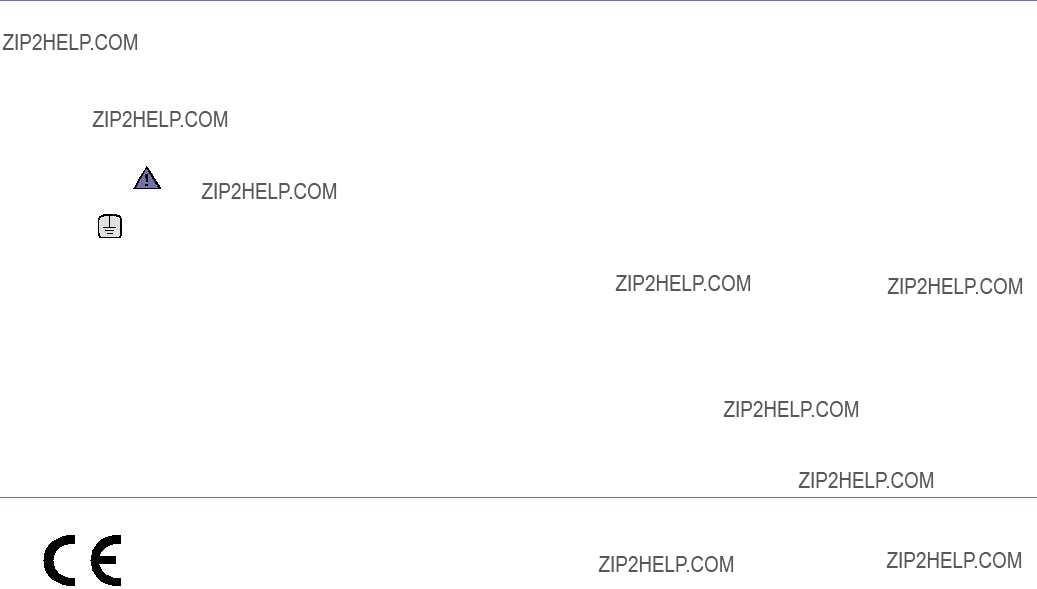
REPLACING THE FITTED PLUG (FOR UK ONLY)
Important
The mains lead for this machine is fitted with a standard (BS 1363) 13 amp plug and has a 13 amp fuse. When you change or examine the fuse, you must
Contact the people from you purchased the machine.
The 13 amp plug is the most widely used type in the UK and should be suitable. However, some buildings (mainly old ones) do not have normal 13 amp plug sockets. You need to buy a suitable plug adaptor. Do not remove the moulded plug.
If you cut off the moulded plug, get rid of it straight away.
You cannot rewire the plug and you may receive an electric shock if you plug it into a socket.
Important warning:
You must earth this machine.
The wires in the mains lead have the following color code:
???Green and Yellow: Earth
???Blue: Neutral
???Brown: Live
If the wires in the mains lead do not match the colors marked in your plug, do the following:
You must connect the green and yellow wire to the pin marked by the letter ???E??? or by the safety ???Earth symbol??? or colored green and yellow or green.
You must connect the blue wire to the pin which is marked with the letter ???N??? or colored black. You must connect the brown wire to the pin which is marked with the letter ???L??? or colored red. You must have a 13 amp fuse in the plug, adaptor, or at the distribution board.
DECLARATION OF CONFORMITY (EUROPEAN COUNTRIES)
Approvals and Certifications
The CE marking applied to this product symbolizes Samsung Electronics Co., Ltd. Declaration of Conformity with the following applicable 93/ 68/EEC Directives of the European Union as of the dates indicated:
January 1, 1995: Council Directive 73/23/EEC Approximation of the laws of the member states related to low voltage equipment.
January 1, 1996: Council Directive 89/336/EEC (92/31/EEC), approximation of the laws of the Member States related to electromagnetic compatibility.
March 9, 1999: Council Directive 1999/5/EC on radio equipment and telecommunications terminal equipment and the mutual recognition of their conformity. A full declaration, defining the relevant Directives and referenced standards can be obtained from your Samsung Electronics Co., Ltd. representative.
EC Certification
Certification to 1999/5/EC Radio Equipment & Telecommunications Terminal Equipment Directive (FAX)
This Samsung product has been
In the event of problems, you should contact the Euro QA Lab of Samsung Electronics Co., Ltd. in the first instance.
The product has been tested against TBR21. To assist in the use and application of terminal equipment which complies with this standard, the European Telecommunication Standards Institute (ETSI) has issued an advisory document (EG 201 121) which contains notes and additional requirements to ensure network compatibility of TBR21 terminals. The product has been designed against, and is fully compliant with, all of the relevant advisory notes contained in this document.
10_Safety information
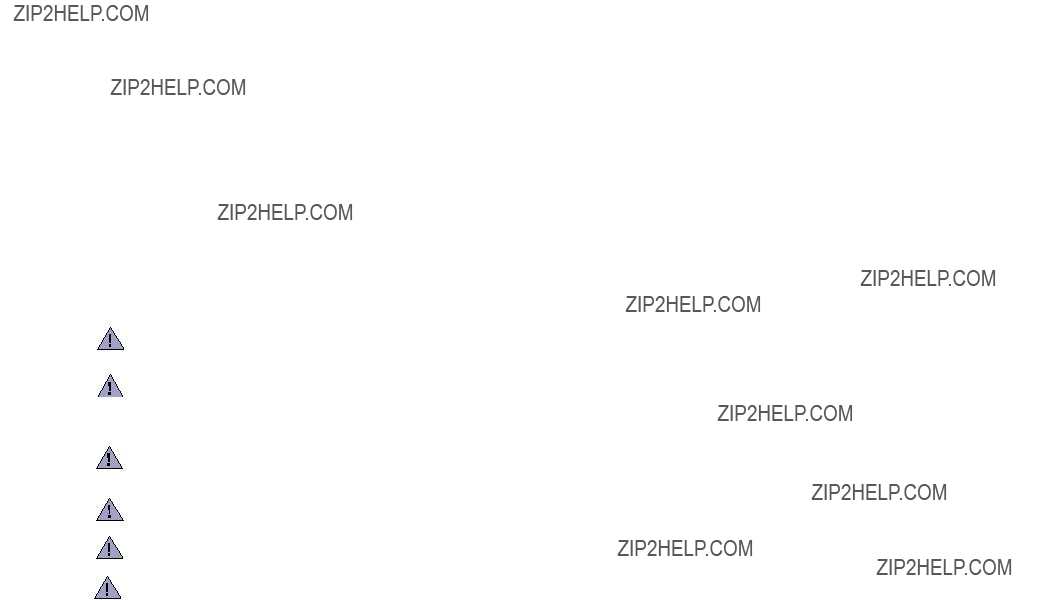
European Radio Approval Information
(for products fitted with
Low power, Radio LAN type devices (radio frequency (RF) wireless communication devices), operating in the 2.4 GHz/5 GHz band, may be present (embedded) in your printer system which is intended for home or office use. This section is only applicable if these devices are present. Refer to the system label to verify the presence of wireless devices.
Wireless devices that may be in your system are only qualified for use in the European Union or associated areas if a CE mark with 
 a Notified Body Registration Number and the Alert Symbol is on the system label.
a Notified Body Registration Number and the Alert Symbol is on the system label.
The power output of the wireless device or devices that may be embedded in you printer is well below the RF exposure limits as set by the European Commission through the R&TTE directive.
European States qualified under wireless approvals:
European States with restrictions on use:
REGULATORY COMPLIANCE STATEMENTS
Wireless Guidance
Low power, Radio LAN type devices (radio frequency (RF) wireless communication devices), operating in the 2.4 GHz/5 GHz Band, may be present (embedded) in your printer system. The following section is a general overview of considerations while operating a wireless device.
Additional limitations, cautions, and concerns for specific countries are listed in the specific country sections (or country group sections). The wireless devices in your system are only qualified for use in the countries identified by the Radio Approval Marks on the system rating label. If the country you will be using the wireless device in, is not listed, contact your local Radio Approval agency for requirements. Wireless devices are closely regulated and use may not be allowed.
The power output of the wireless device or devices that may be embedded in your printer is well below the RF exposure limits as known at this time. Because the wireless devices (which may be embedded into your printer) emit less energy than is allowed in radio frequency safety standards and recommendations, manufacturer believes these devices are safe for use. Regardless of the power levels, care should be taken to minimize human contact during normal operation.
As a general guideline, a separation of 20 cm (8 inches) between the wireless device and the body, for use of a wireless device near the body (this does not include extremities) is typical. This device should be used more than 20 cm (8 inches) from the body when wireless devices are on and transmitting.
This transmitter must not be collocated or operation in conjunction with any other antenna or transmitter.
Some circumstances require restrictions on wireless devices. Examples of common restrictions are listed below:
Radio frequency wireless communication can interfere with equipment on commercial aircraft. Current aviation regulations require wireless devices to be turned off while traveling in an airplane. IEEE 802.11 (also known as wireless Ethernet) and Bluetooth communication devices are examples of devices that provide wireless communication.
In environments where the risk of interference to other devices or services is harmful or perceived as harmful, the option to use a wireless device may be restricted or eliminated. Airports, Hospitals, and Oxygen or flammable gas laden atmospheres are limited examples where use of wireless devices may be restricted or eliminated. When in environments where you are uncertain of the sanction to use wireless devices, ask the applicable authority for authorization prior to use or turning on the wireless device.
Every country has different restrictions on the use of wireless devices. Since your system is equipped with a wireless device, when traveling between countries with your system, check with the local Radio Approval authorities prior to any move or trip for any restrictions on the use of a wireless device in the destination country.
If your system came equipped with an internal embedded wireless device, do not operate the wireless device unless all covers and shields are in place and the system is fully assembled.
Wireless devices are not user serviceable. Do not modify them in any way. Modification to a wireless device will void the authorization to use it. Contact manufacturer for service.
Only use drivers approved for the country in which the device will be used. See the manufacturer System Restoration Kit, or contact manufacturer Technical Support for additional information.
Safety information_11

OPENSSL LICENSE
Copyright (c)
Redistribution and use in source and binary forms, with or without modification, are permitted provided that the following conditions are met:
1.Redistributions of source code must retain the above copyright notice, this list of conditions and the following disclaimer.
2.Redistributions in binary form must reproduce the above copyright notice, this list of conditions and the following disclaimer in the documentation and/or other materials provided with the distribution.
3.All advertising materials mentioning features or use of this software must display the following acknowledgment: "This product includes software developed by the OpenSSL Project for use in the OpenSSL Toolkit. (http://www.openssl.org/)"
4.The names "OpenSSL Toolkit" and "OpenSSL Project" must not be used to endorse or promote products derived from this software without
5.prior written permission. For written permission, please contact
6.Products derived from this software may not be called "OpenSSL" nor may "OpenSSL" appear in their names without prior written permission of the OpenSSL Project.
7.Redistributions of any form whatsoever must retain the following acknowledgment: "This product includes software developed by the OpenSSL Project for use in the OpenSSL Toolkit (http://www.openssl.org/)"
THIS SOFTWARE IS PROVIDED BY THE OpenSSL PROJECT ``AS IS'' AND ANY EXPRESSED OR IMPLIED WARRANTIES, INCLUDING, BUT
NOT LIMITED TO, THE IMPLIED WARRANTIES OF MERCHANTABILITY AND FITNESS FOR A PARTICULAR PURPOSE ARE DISCLAIMED. IN NO EVENT SHALL THE OpenSSL PROJECT OR ITS CONTRIBUTORS BE LIABLE FOR ANY DIRECT, INDIRECT, INCIDENTAL, SPECIAL,
EXEMPLARY, OR CONSEQUENTIAL DAMAGES (INCLUDING, BUT NOT LIMITED TO, PROCUREMENT OF SUBSTITUTE GOODS OR
SERVICES; LOSS OF USE, DATA, OR PROFITS; OR BUSINESS INTERRUPTION) HOWEVER CAUSED AND ON ANY THEORY OF LIABILITY,
WHETHER IN CONTRACT, STRICT LIABILITY, OR TORT (INCLUDING NEGLIGENCE OR OTHERWISE) ARISING IN ANY WAY OUT OF THE
USE OF THIS SOFTWARE, EVEN IF ADVISED OF THE POSSIBILITY OF SUCH DAMAGE.
This product includes cryptographic software written by Eric Young(eay@cryptsoft.com). This product includes software written by Tim Hudson (tjh@cryptsoft.com).
ORIGINAL SSLEAY LICENSE
Copyright (C)
This package is an SSL implementation written by Eric Young (eay@cryptsoft.com). The implementation was written so as to conform with Netscapes SSL.
This library is free for commercial and
Redistribution and use in source and binary forms, with or without modification, are permitted provided that the following conditions are met:
1.Redistributions of source code must retain the copyright notice, this list of conditions and the following disclaimer.
2.Redistributions in binary form must reproduce the above copyright notice, this list of conditions and the following disclaimer in the documentation and/or other materials provided with the distribution.
3.All advertising materials mentioning features or use of this software must display the following acknowledgement: "This product includes cryptographic software written by Eric Young (eay@cryptsoft.com)" The word 'cryptographic' can be left out if the rouines from the library being used are not cryptographic
4.If you include any Windows specific code (or a derivative thereof) from the apps directory (application code) you must include an acknowledgement: "This product includes software written by Tim Hudson (tjh@cryptsoft.com)"
THIS SOFTWARE IS PROVIDED BY ERIC YOUNG ``AS IS'' AND ANY EXPRESS OR IMPLIED WARRANTIES, INCLUDING, BUT NOT LIMITED
TO, THE IMPLIED WARRANTIES OF MERCHANTABILITY AND FITNESS FOR A PARTICULAR PURPOSE ARE DISCLAIMED. IN NO EVENT
SHALL THE AUTHOR OR CONTRIBUTORS BE LIABLE FOR ANY DIRECT, INDIRECT, INCIDENTAL, SPECIAL, EXEMPLARY, OR
CONSEQUENTIAL DAMAGES (INCLUDING, BUT NOT LIMITED TO, PROCUREMENT OF SUBSTITUTE GOODS OR SERVICES; LOSS OF USE,
DATA, OR PROFITS; OR BUSINESS INTERRUPTION) HOWEVER CAUSED AND ON ANY THEORY OF LIABILITY, WHETHER IN CONTRACT,
STRICT LIABILITY, OR TORT (INCLUDING NEGLIGENCE OR OTHERWISE) ARISING IN ANY WAY OUT OF THE USE OF THIS SOFTWARE,
EVEN IF ADVISED OF THE POSSIBILITY OF SUCH DAMAGE.
The licence and distribution terms for any publically available version or derivative of this code cannot be changed. i.e. this code cannot simply be copied and put under another distribution licence [including the GNU Public Licence.
12_Safety information

Safety information_13

contents
20Windows
21Supported operation environments
21Printing Configuration report
23Installing the driver software
23Using a wireless
23Checking your Network Environments
24Printing Configuration report
25 Restoring factory default settings
25Configuring the machine???s wireless network
26Installing the driver software
29Specifications on print media
30Guidelines for special print media
31Changing the size of the paper in the paper tray
33Printing on special print materials
14_Contents

contents
35
38Replacing the toner cartridge
40Replacing the waste toner container
41 Managing your machine from the website
41 To access SyncThru??? Web Service:
Contents_15
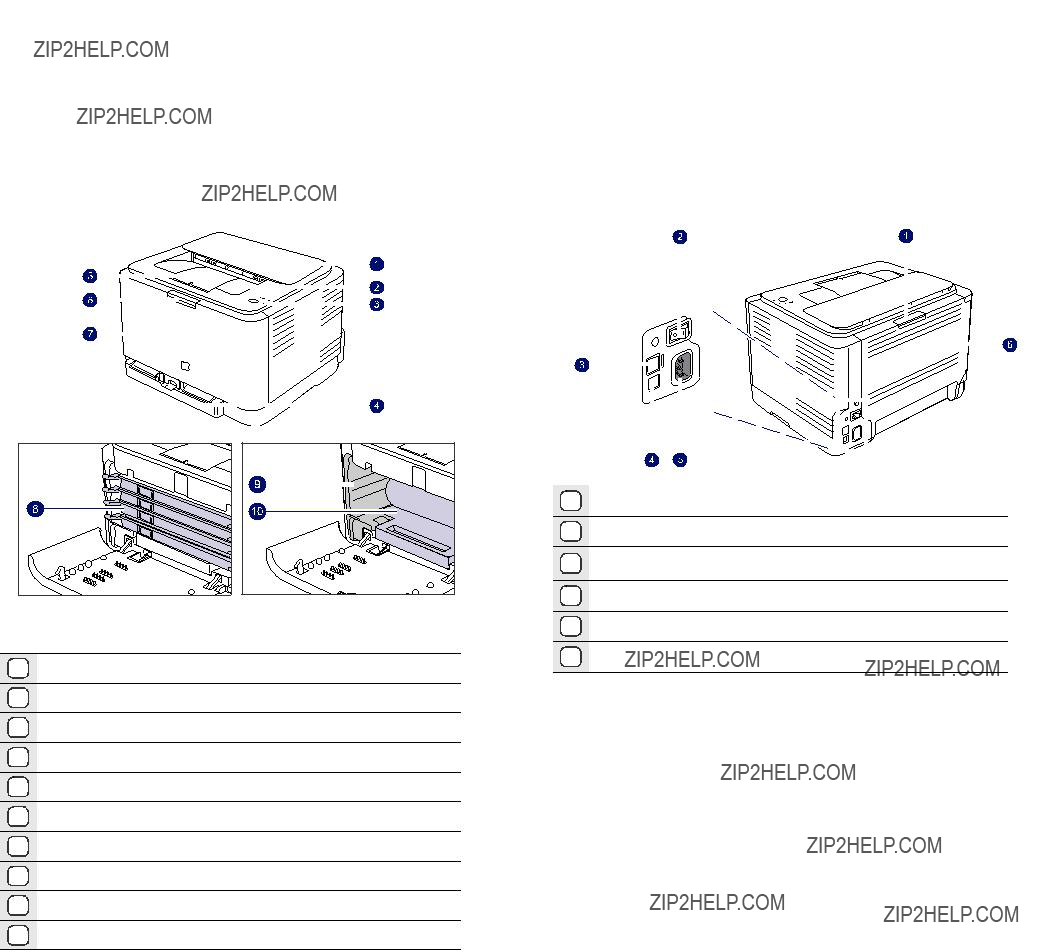
introduction
These are the main components of your machine:
???Understanding the control panel
PRINTER OVERVIEW
1Top cover
2Output tray (face down)
3Control panel
4Tray
5Output support
6Front cover release button
7Front cover
8Toner cartridge
9Waste toner container
1 Rear cover release button
 2 Power switch
2 Power switch
3Network porta
4USB port
 5 Power receptacle
5 Power receptacle
 6 Rear cover
6 Rear cover
16 _Introduction
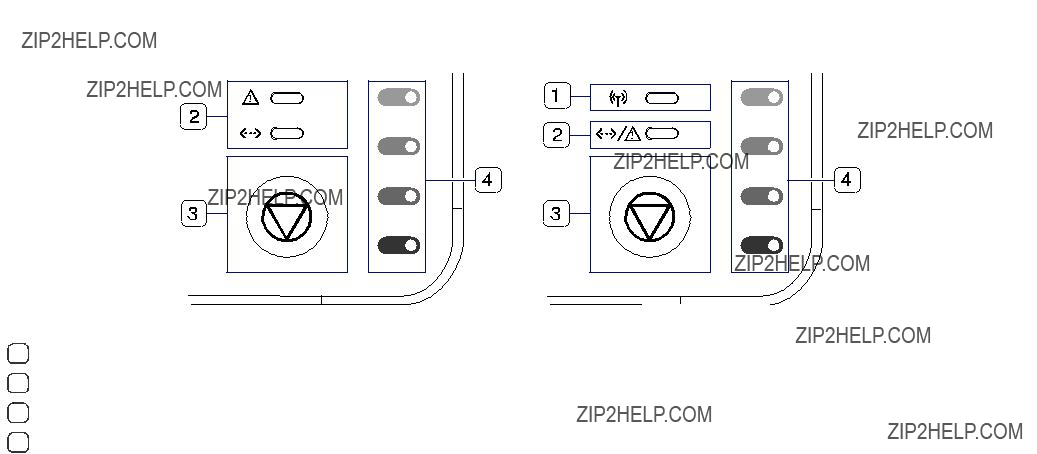
CONTROL PANEL OVERVIEW
Introduction_ 17

UNDERSTANDING THE CONTROL PANEL
The color of the status and toner colors LED indicates the machine's current status.
LEDs
a.Estimated lifespan means the expected or estimated print cartridge life, which indicates the average capacity of
All printing errors will be appear in the Smart Panel program window.
 Stop button
Stop button
18 _Introduction

SUPPLIED SOFTWARE
You must install the printer software using the supplied CD after you have set up your machine and connected it to your computer. CD provides you with the following software.
PRINTER DRIVER FEATURES
Your printer drivers support the following standard features:
???Paper orientation, size, source and media type selection
???Number of copies
In addition, you can use various special printing features. The following table shows a general overview of features supported by your printer drivers:
Some models or operating system may not support the certain feature(s) in the following table.
Printer driver
Introduction_ 19
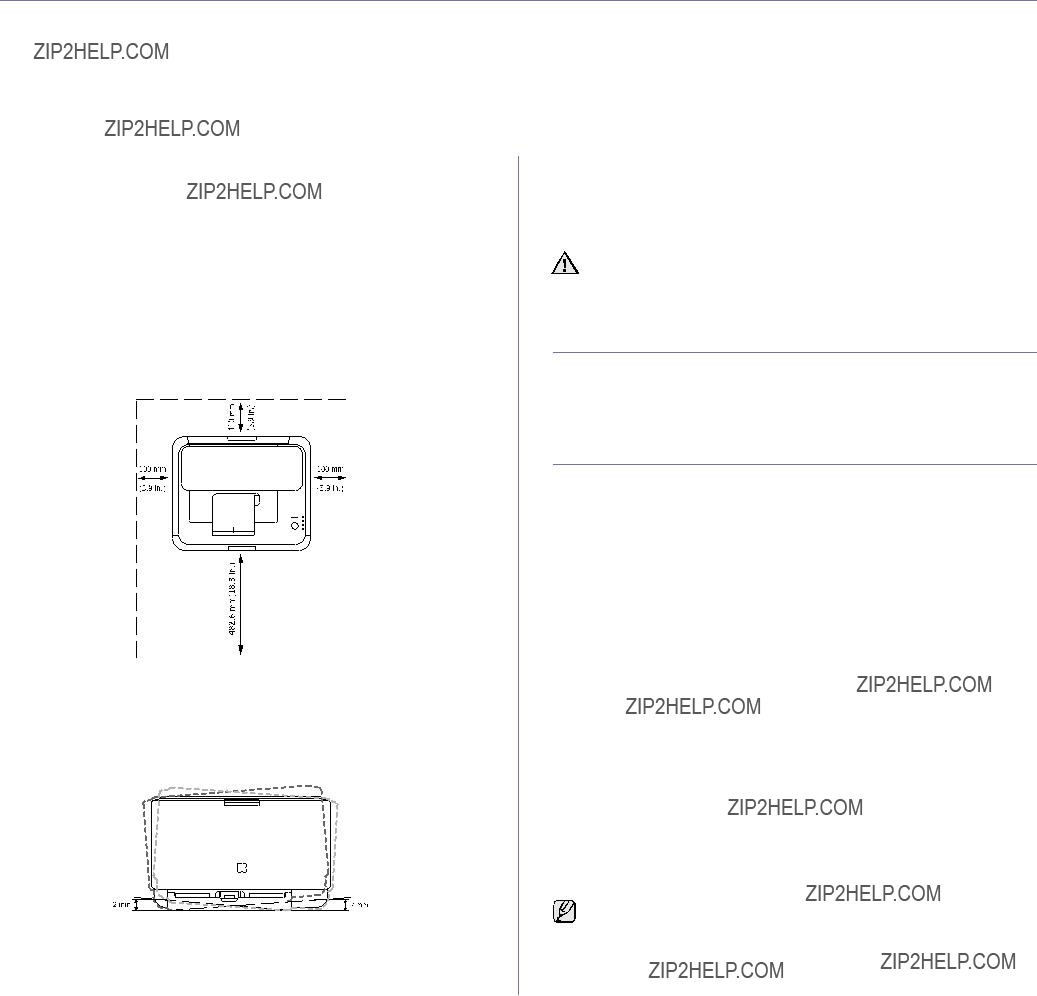
getting started
This chapter gives you
This chapter includes:
SETTING UP THE HARDWARE
This section shows the steps to set up the hardware which is explained in the Quick Install Guide. Make sure you read Quick Install Guide and complete following steps.
1.Select a stable location.
Select a level, stable place with adequate space for air circulation. Allow extra space to open covers and trays.
The area should be
Printing is suitable for altitudes under 1,000 m (3,281 ft). Refer to the altitude setting to optimize your printing. See "Altitude adjustment" on page 27 for more information.
Place the machine on a flat and stable surface, not letting it lean more than 2 mm (0.08 inches). Otherwise, it may affect the printing quality.
2.Unpack the machine and check all the enclosed items.
3.Remove the tape holding the machine tightly.
???Using a wireless
4.Load paper. (See "Changing the size of the paper in the paper tray" on page 31.)
5.Make sure that all the cables are connected to the machine.
6.Turn the machine on.
When you move the machine, do not tilt or turn it upside down. Otherwise, the inside of the machine may be contaminated by toner, which can cause damage to the machine or bad print quality.
PRINTING A DEMO PAGE
Print a demo page to make sure that the machine is operating correctly. To print a demo page:
In ready mode, press and hold the  Stop button for about 2 seconds.
Stop button for about 2 seconds.
SYSTEM REQUIREMENTS
Before you begin, ensure that your system meets the following requirements:
Windows
Your machine supports the following Windows operating systems.
??? Internet Explorer 6.0 or higher is the minimum requirement for all Windows operating systems.
???Users who have an administrator right can install the software.
???Windows Terminal Services is compatable with this machine.
20 _Getting started
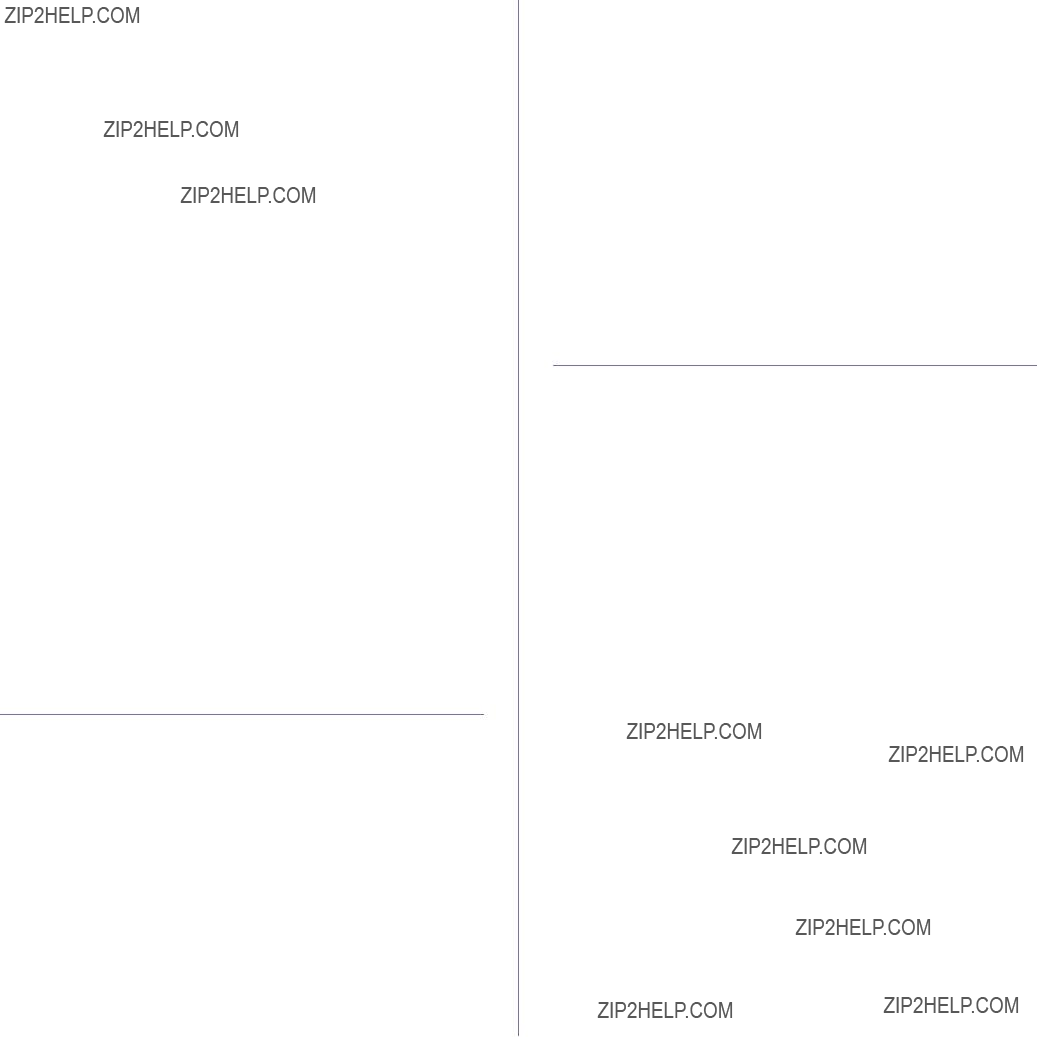
Macintosh
Linux
SETTING UP THE NETWORK
You need to set up the network protocols on the machine (;printer) to use it in the network environment. If you use your machine in the wired network, refer to 'Using a wired network'. If you use your network printer in the wireless network, refer to "Using a wireless
Supported operation environments
The following table shows the network environments supported by the machine:
USING A WIRED NETWORK
You must set up the network protocols on your printer to use it on your network. This chapter will show you how this is easily accomplished.
Printing Configuration report
You can print a Network Configuration Report from the machine's control panel that will show the current machine???s network settings. This will help you to set up a network and troubleshooting problems.
To print the report, you need to press and hold  Stop for about 5 seconds.
Stop for about 5 seconds.
Please review your machines User's Guide to learn of more details. Using this Network Configuration Report, you can find your machine???s MAC address and IP address.
Setting IP address
Firstly, you have to set up an IP address for network printing and managements. In most cases a new IP address will be automatically assigned by a DHCP (Dynamic Host Configuration Protocol Server) located on the network.
In a few situations the IP address must be set manually. This is called a static IP and is often required in corporate Intranets for security reasons.
Getting started_ 21

???DHCP IP assignment: Connect your machine to the network, and wait a few minutes for the DHCP server to assign an IP address to the machine. Then, print the Network Configuration Report as explained above. If the report shows that the IP address has changed, the assignment was successful. You will see the new IP address on the report.
???Static IP assignment: Use SetIP program to change the IP address from your computer.
In an office environment, we recommend that you contact a network administrator to set this address for you.
IP setting using the SetIP program
The following procedure is based on Windows XP.
This program is for manually setting the network IP address of your machine using its MAC address to communicate with the machine. MAC address is a hardware serial number of the network interface and can be found in the Network Configuration Report.
??? You only need to run this program if your network requires a static IP address. Otherwise, you may proceed to the
Configuring the machine???s wireless network part of this document. If you are unsure of this requirement ask the system administrator or the person who has set up your local network.
???You can only use the SetIP program when your machine is connected to a network or directly connected to a PC with the crossover network cable included with your machine. In most cases we recommend using the crossover cable. You will be asked to connect this cable in a moment.
Installing the program
1.Insert the Printer Software
2.Start a web browser such as Internet Explorer and open the X drive. (X represents your
3.
4.
5.Click OK. If necessary, select a language from the
6.Follow the instructions in the window and complete the installation.
Starting the program
1.Connect your machine and the computer using crossover network cable.
2.Temporarily disable the computer firewall before continuing by doing the following:
3.From the Windows Start menu, select All Programs > Samsung Network Printer Utilities > SetIP > SetIP.
4.Click on the  icon (third from left) in the SetIP window to open the TCP/IP configuration window.
icon (third from left) in the SetIP window to open the TCP/IP configuration window.
5.Enter the machine???s new information into the configuration window as follows:
???MAC Address : Find the machine???s MAC address from the Network Configuration Report and enter it without the colons.
For example, 00:15:99:29:51:A8 becomes 0015992951A8.
MAC address is a hardware serial number of the machine???s network interface and can be found in on the Network Configuration Report.
???IP Address: Enter a new IP address for your printer the same as the computer???s IP address except for the last number.
For example, if your computer???s IP address is 192.168.1.150, enter 192.168.1.X. (X is number between 1 and 254 other than the computer???s address.)
???Subnet Mask: Enter this exactly the same as the computer???s Subnet Mask.
???Default Gateway: Enter this exactly the same as the computer???s Default Gateway.
6.Click Apply, and then click OK. The machine will automatically print the Configuration report. Confirm that all the settings are correct.
7.Click Exit to close the SetIP program.
8.If necessary, restart the computer???s firewall.
Network parameter setting
You can also set up the various network settings through the network administration programs.
???SyncThru??? Web Admin Service:
???SyncThru??? Web Service: Web server embedded on your network print
server, which allows you to: (A) Configure the network parameters necessary for the machine to connect to various network environments.
(B) Customize machine settings.
22 _Getting started

Installing the driver software
You must install the printer driver software for printing. The software includes drivers, applications, and other user friendly programs.
The following procedure is based on Windows XP. The procedure and popup window which appears during the installation may differ depending on the operating system, machine features, or the interface in use.
Make sure that the network setup for your machine is completed. (See "Setting up the network" on page 21.) All applications should be closed on your computer before beginning the installation.
If your IP assignment method is DHCP and IP address can be changed whenever machine in turned on, we recommend you to use the Bonjour program. Go to the http://developer.apple.com/networking/bonjour/ download/, select the program Bonjour for Windows according to your computer operating system, and install the program. In case of Mac OS X, this program might be already installed in your PC. This program will allow you to fix the network parameter automatically. This Bonjour program does not support Linux.
If your IP assignment method is static, follow the steps below.
1.Insert the Printer Software
2.Click Next.
???If the installation window does not appear, click Start > Run. Type X:\Setup.exe, replacing ???X??? with the letter which represents your drive and click OK.
???If you use Windows Vista, click Start > All Programs >
Accessories > Run, and type X:\Setup.exe.
??? The installation window may slightly differ, if you are reinstalling the driver.
???View User???s Guide: Allows you to view the User???s Guide. If your computer does not have Adobe Acrobat, click on this option and it will automatically install Adobe Acrobat Reader for you.
3.Select Typical installation for a network printer, and then click Next.
4.The list of machines available on the network appears. Select the printer you want to install from the list and then click Next.
??? If you do not see your machine on the list, click Update to refresh the list, or select Add TCP/IP Port to add your machine to the network. To add the machine to the network, enter the port name and the IP address for the machine.
???To verify your machine???s IP address or the MAC address, print a Network Configuration Report page.
5.After the installation is finished, a window appears asking you to print a test page and to register yourself as a user of Samsung machines in order to receive information from Samsung. If you wish to do so, select the corresponding checkbox(es) and click Finish.
If your machine does not work properly after the installation, verify your network settings and try reinstalling the printer driver.
USING A WIRELESS
You must set up the network protocols on your machine to use it on your network. This chapter will show you how this is easily accomplished.
Before starting, please locate the crossover network cable and the Printer Software Installation
If you are already aware of your machine???s IP address configuration and this IP address is available, you may go to Configuring the machine???s wireless network part directly. Otherwise you have to follow all steps from
Checking your Network Environments part.
Checking your Network Environments
IP address
Every device in a network is identified by a unique numerical address called an IP Address. Your machine came with a default IP address of 192.0.0.192, and you can verify this by printing out a Network Configuration Report. In most cases a new IP address will be automatically assigned by a DHCP (Dynamic Host Configuration Protocol Server) located on the network.
In a few situations the IP address must be set manually. This is called a static IP and is often required in corporate Intranets for security reasons. We have provided an easy to use utility program on the Printer Software
In an office environment, we recommend that you contact a network administrator to set this address for you.
Wireless Networks
???Infrastructure mode: An Infrastructure mode network is the most common wireless network configuration in a home or office consisting of a wireless router, or an access point, that connects all the computers and other networked devices into a common local area network (LAN).
The access point provides a special high speed connection to a Cable or DSL modem or other wide area network (WAN) device that connects the LAN to the Internet or a Corporate Intranet. Most Infrastructure mode networks use a DHCP Server to automatically assign the IP address and set other network parameters.
If you know that you are connecting to an Infrastructure mode network with an access point, and the IP address is assigned by a DHCP server, you may proceed to the Configuring the machine???s wireless network part after reviewing the following parts on printing a Network Configuration Report.
If you know that you are connecting to an Infrastructure mode network with an access point, but it does not have DHCP address assignment, or you are required to set a static IP, proceed to the
Setting IP address part before going to Configuring the machine???s wireless network part after reviewing the following parts on printing a Network Configuration Report.
???
Getting started_ 23
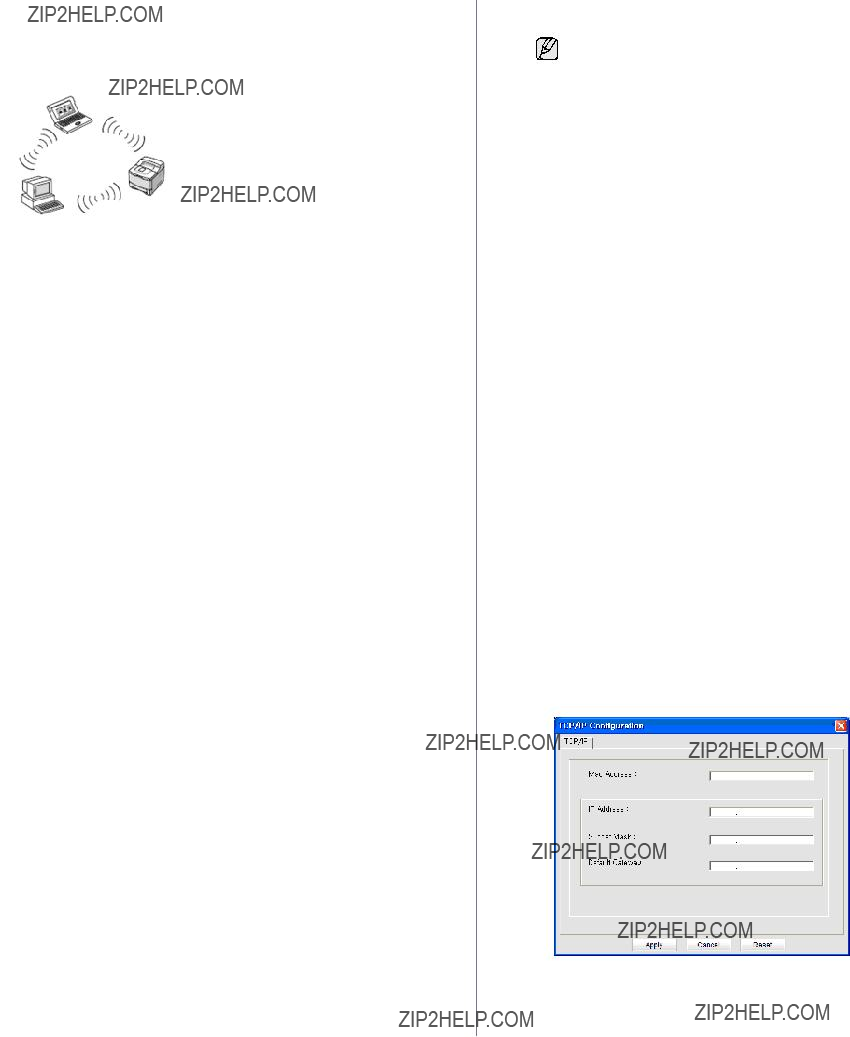
communication. In an
If you know that you are connecting to an
Configuring the machine???s wireless network part after reviewing the following parts on printing a Network Configuration Report.
Printing Configuration report
You can print a Network Configuration Report from the machine???s control panel that will show the current machine???s network settings. This will help you to set up a network and troubleshooting problems.
To print the report, you need to press and hold  Stop for about 5 seconds.
Stop for about 5 seconds.
Please review your machines User???s Guide to learn of additional details. Using this Network Configuration Report, you can find your machine MAC address and IP address.
Setting IP address
Firstly, you have to set up an IP address for network printing and managements. In most cases a new IP address will be automatically assigned by a DHCP (Dynamic Host Configuration Protocol Server) located on the network.
In a few situations the IP address must be set manually. This is called a static IP and is often required in corporate Intranets for security reasons.
???DHCP IP assignment: Connect your machine to the network, and wait a few minutes for the DHCP server to assign an IP address to the machine. (If the access point has an available LAN port, you may connect your machine directly to the access point.) Then, print the Network Configuration Report as explained above. If the report shows that the IP address has changed, the assignment was successful. You will see the new IP address in the report. Leave the machine attached to the network.
???Static IP assignment: Use SetIP program to change the IP address from your computer. If your machine has a control panel, you can also change IP address using the machine's control panel.
In an office environment, we recommend that you contact a network administrator to set this address for you.
IP setting using SetIP program
The following procedure is based on Windows XP.
This program is for manually setting the network IP address of your machine using its MAC address to communicate with the machine. A
MAC address is the hardware serial number of the network interface and can be found in the Network Configuration Report.
??? You only need to run this program if your network requires a static IP address. Otherwise, you may proceed to the
Configuring the machine???s wireless network part of this document. If you are unsure of this requirement ask the system administrator or the person who has set up your local network.
???You can only use the SetIP program when your machine is connected to a network or directly connected to a PC with the crossover network cable included with your machine. In most cases we recommend using the crossover cable. You will be asked to connect this cable in a moment.
Installing the program
1.Insert the Printer Software
2.Start a web browser such as Internet Explorer and open the X drive. (X represents your
3.
4.
5.Click OK. If necessary, select a language from the
6.Follow the instructions in the window and complete the installation.
Starting the program
1.Connect your machine and the computer using crossover network cable.
2.Temporarily disable the computer firewall before continuing by doing the following:
3.From the Windows Start menu, select All Programs > Samsung Network Printer Utilities > SetIP > SetIP.
4.Click on the  icon (third from left) in the SetIP window to open the TCP/IP configuration window.
icon (third from left) in the SetIP window to open the TCP/IP configuration window.
5.Enter the machine???s new information into the configuration window as follows:
???MAC Address : Find the machine???s MAC address from the Network Configuration Report and enter it without the colons.
24 _Getting started

For example, 00:15:99:29:51:A8 becomes 0015992951A8.
MAC address is a hardware serial number of the machine???s network interface and can be found in the Network Configuration Report.
???IP Address: Enter a new IP address for your printer the same as the computer???s IP address except for the last number.
For example, if your computer???s IP address is 192.168.1.150, enter 192.168.1.X. (X is number between 1 and 254 other than the computer???s address.)
???Subnet Mask: Enter this exactly the same as the computer???s Subnet Mask.
???Default Gateway: Enter this exactly the same as the computer???s Default Gateway.
6.Click Apply, and then click OK. The machine will automatically print the Configuration report. Confirm that all the settings are correct.
7.Click Exit to close the SetIP program.
8.If necessary, restart the computer???s firewall.
Network parameter setting
You can also set up the various network settings through the network administration programs.
???SyncThru??? Web Admin Service:
???SyncThru??? Web Service: Web server embedded on your network print
server, which allows you to: (A) Configure the network parameters necessary for the machine to connect to various network environments.
(B) Customize machine settings.
Restoring factory default settings
You can restore factory default settings to the machine by using SyncThru??? Web Service. You may need to reset the machine to the factory default settings when machine that you are using is connected to new network environment.
Restoring factory default settings using SyncThru??? Web Service
1.Start a web browser such as Internet Explorer, Safari or Firefox and enter your machine???s new IP address in the browser window.
For example,
2.When the SyncThru??? Web Service window opens, click Network Settings.
3. Click Reset. Then, click Clear for network.
4. Turn off and restart machine to apply settings.
Configuring the machine???s wireless network
Before starting you will need to know the SSID of your wireless network and the Network Key if it is encrypted. This information was set when the access point was installed. If you do not know about your wireless environment, please ask the person who has set up your network.
Using SyncThru??? Web Service
Before starting wireless parameter configuration, make sure cable connection status.
Configuring the printer???s wireless network
1.Start a web browser such as Internet Explorer, Safari or Firefox and enter your machine???s new IP address in the browser window.
For example,
2.When the SyncThru Web Service window opens, click Network Settings.
3.Click Wireless and Select Wizard. Then, click Next.
Wizard will help you setup the wireless network configuration. However, if you want to set the wireless network directly, select
Custom.
Getting started_ 25

4. Select the one Network Name(SSID) in the list.
???SSID: SSID(Service Set Identifier) is a name that identifies a wireless network. Access points and wireless devices attempting to connect to a specific wireless network must use the same SSID. The SSID is
???Operation Mode: Operation Mode refers to the type of wireless connections.
-
-Infrastructure: allows wireless devices to communicate with each
other through an access point.
If your network???s operation mode is Infrastructure, select the SSID of the access point. If the operation mode is
5.Click Next.
If wireless security setting window appears, enter the registered password (network key) and click Next.
6.Wizard Setup Confirmation window appears, please check your wireless setup. If the setup is right, click Apply.
7. Click OK.
Disconnect the network cable (standard or crossover). Your machine should then start communicating wirelessly with the network. In case of
If Operation Mode is Infrastructure, you must disconnect the network cable to activate wireless network after completing the network setting.
Now go to Installing the driver software.
Installing the driver software
You must install the printer driver software for printing. The software includes drivers, applications, and other user friendly programs.
??? The following procedure is based on Windows XP. The procedure and popup window which appears during the installation may differ depending on the operating system, machine features, or the interface in use.
???Make sure that the network setup for your machine is completed. (See "Setting up the network" on page 21.) All applications should be closed on your computer before beginning installation.
If your IP assignment method is DHCP and IP address can be changed whenever machine is turned on, we recommend you to use the Bonjour program. Go to the http://developer.apple.com/networking/bonjour/ download/, select the program Bonjour for Windows according to your computer operating system, and install the program. In case of Mac OS X, this program might be already installed in your PC. This program will allow you to fix the network parameter automatically. This Bonjour program does not support Linux.
If your IP assignment method is static, follow the steps below.
1.Insert the Printer Software
2.Click Next.
???If the installation window does not appear, click Start > Run. Type X:\Setup.exe, replacing ???X??? with the letter which represents your drive and click OK.
???If you use Windows Vista, click Start > All Programs >
Accessories > Run, and type X:\Setup.exe.
??? The installation window may slightly differ, if you are reinstalling the driver.
???View User???s Guide: Allows you to view the User???s Guide. If your computer does not have Adobe Acrobat, click on this option and it will automatically install Adobe Acrobat Reader for you.
3.Select Typical installation for a network printer, and then click Next.
4.The list of machines available on the network appears. Select the printer you want to install from the list and then click Next.
??? If you do not see your machine on the list, click Update to refresh the list, or select Add TCP/IP Port to add your machine to the network. To add the machine to the network, enter the port name and the IP address for the machine.
???To verify your machine???s IP address or the MAC address, print a Network Configuration Report page.
5.After the installation is finished, a window appears asking you to print a test page and to register yourself as a user of Samsung machines in order to receive information from Samsung. If you wish to do so, select the corresponding checkbox(es) and click Finish.
If your machine does not work properly after the installation, verify your network settings and try reinstalling the printer driver.
26 _Getting started
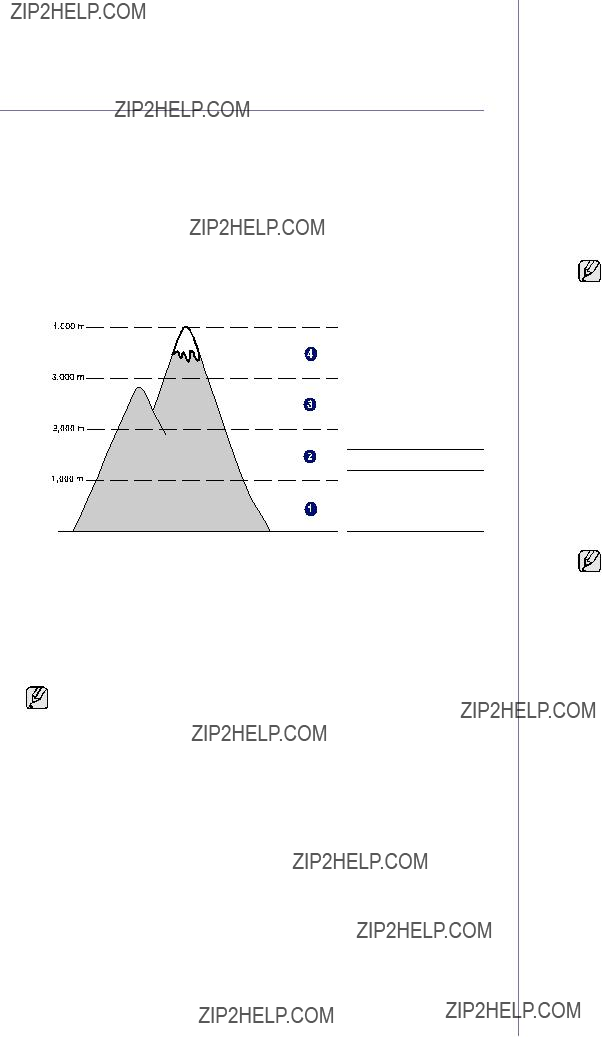
Congratulations, you have installed your Samsung wireless network printer. Print another copy of the Configuration report and keep it for future reference. You are now ready to use your new Samsung wireless printer on your network.
MACHINE'S BASIC SETTINGS
After installation is complete, you may want to set the machine's default settings. Refer to the next section if you would like to set or change values.
Altitude adjustment
The print quality is affected by atmospheric pressure, which is determined by the height of the machine above sea level. The following information will guide you on how to set your machine to the best print quality or best quality of print.
Before you set the altitude value, find the altitude where you are using the machine.
1 Normal
2 High 1
3 High 2
4 High 3
0
1.Ensure that you have installed the printer driver with the provided Printer Software CD.
2.
You can also click Smart Panel on the status bar in Mac OS X.
3.Click Printer Setting.
4.Click Setting > Altitude Adjustment. Select the appropriate value from the dropdown list, and then click Apply.
If your machine is connected to a network, SyncThru??? Web Service screen appears automatically. Click Machine Settings > Setup (or Machine Setup) > Altitude. Select the appropriate altitude value, and then click Apply.
Using the save modes
Power Save mode
Power Save mode allows your machine to reduce power consumption when it is not in actual use. You can turn this mode on and select a length of time for which the machine waits after a job is printed before it switches to a reduced power state.
1.Ensure that you have installed the printer driver with the provided Printer Software CD.
2.
You can also click Smart Panel on the status bar in Mac OS X.
3.Click Printer Setting.
4.Click Setting > Power Save. Select the appropriate value from the dropdown list, and then click Apply.
If your machine is connected to a network, SyncThru??? Web Service screen appears automatically. Click Machine Settings >
Setup (or Machine Setup) > Power Save. Select the appropriate altitude value, and then click Apply.
Auto continue
This is the option to set the machine to continue printing or not, in case the paper size you have set and the paper within the tray mismatches.
1.Ensure that you have installed the printer driver with the provided Printer Software CD.
2.
You can also click Smart Panel on the status bar in Mac OS X.
3.Click Printer Setting.
4.Click Setting > Auto Continue. Select the appropriate value from the dropdown list, and then click Apply.
If your machine is connected to a network, SyncThru??? Web Service screen appears automatically. Click Machine Settings >
Setup (or Machine Setup) > Auto Continue. Select the appropriate altitude value, and then click Apply.
Getting started_ 27

selecting and loading print media
This chapter introduces you how to load originals and print media into your machine.
???Printing on special print materials
SELECTING PRINT MEDIA
You can print on a variety of print media, such as plain paper, envelopes, labels, and transparencies. Always use print media that meet the guidelines for use with your machine. Print media that does not meet the guidelines outlined in this user???s guide may cause the following problems:
???Poor print quality
???Increased paper jams
???Premature wear on the machine.
Properties, such as weight, composition, grain, and moisture content, are important factors that affect the machine???s performance and the output quality. When you choose print materials, consider the following:
???The type, size and weight of the print media for your machine are described later in this section.
???Desired outcome: The print media you choose should be appropriate for your project.
???Brightness: Some print media are whiter than others and produce sharper, more vibrant images.
???Surface smoothness: The smoothness of the print media affects how crisp the printing looks on the paper.
??? Some print media may meet all of the guidelines in this section and still not produce satisfactory results. This may be the result of improper handling, unacceptable temperature and humidity levels, or other variables over which Samsung has no control.
???Before purchasing large quantities of print media, ensure that it meets the requirements specified in this user???s guide.
Using print media that does not meet these specifications may cause problems, requiring repairs. Such repairs are not covered by Samsung???s warranty or service agreements.
Make sure not to use the inkjet photo paper with this machine. It could cause damage to the machine.
Selecting and loading print media_ 28
Specifications on print media
a.If media weight is over 105 g/m2 (28 lb bond), load a paper into the tray one by one.
b.Maximum capacity may differ depending on media weight, thickness, and environmental conditions.
c.Smoothness: 100 to 250 (sheffield)
d.Recommended media: Transparency for a color laser printer by Xerox such as 3R 91331(A4), 3R 2780(Letter).
e.Recommended media: Glossy paper (Letter) for this machine by HP Brochure Paper (Product: Q6611A) only.
f.Recommended media: Glossy paper (A4) for this machine by HP Superior Paper 160 glossy (Product: Q6616A) only.
29 _Selecting and loading print media

Guidelines for special print media
???Envelopes with a
???For the best print quality, position margins no closer than 15 mm from the edges of the envelope.
???Avoid printing over the area where the envelope???s seams meet.
Using photographic paper or coated paper may cause problems, requiring repairs. Such repairs are not covered by Samsung???s warranty or service agreements.
30 _Selecting and loading print media

CHANGING THE SIZE OF THE PAPER IN THE
PAPER TRAY
To load different sizes of paper, such as
To change the tray size to other size, you must adjust the paper length guide properly.
1 Tray extend lever
2 Paper length guide
3 Paper width guide
4 Paper cover
1.Pull the tray out of the machine. Open the paper cover and remove paper from the tray if necessary.
2.Pressing and unlatching the guide lock in the top of the tray, pull the tray out manually.
3. Load paper into the tray.
4.Slide the paper length guide until it lightly touches the end of the paper stack. Squeeze the paper width guide and slide it to the edge of the paper stack without causing it to bend.
For paper smaller than
If the paper that you need to print is shorter than length 222 mm (8.74 inches), press and unlatch the guide lock in the tray, push the tray in
Selecting and loading print media_ 31
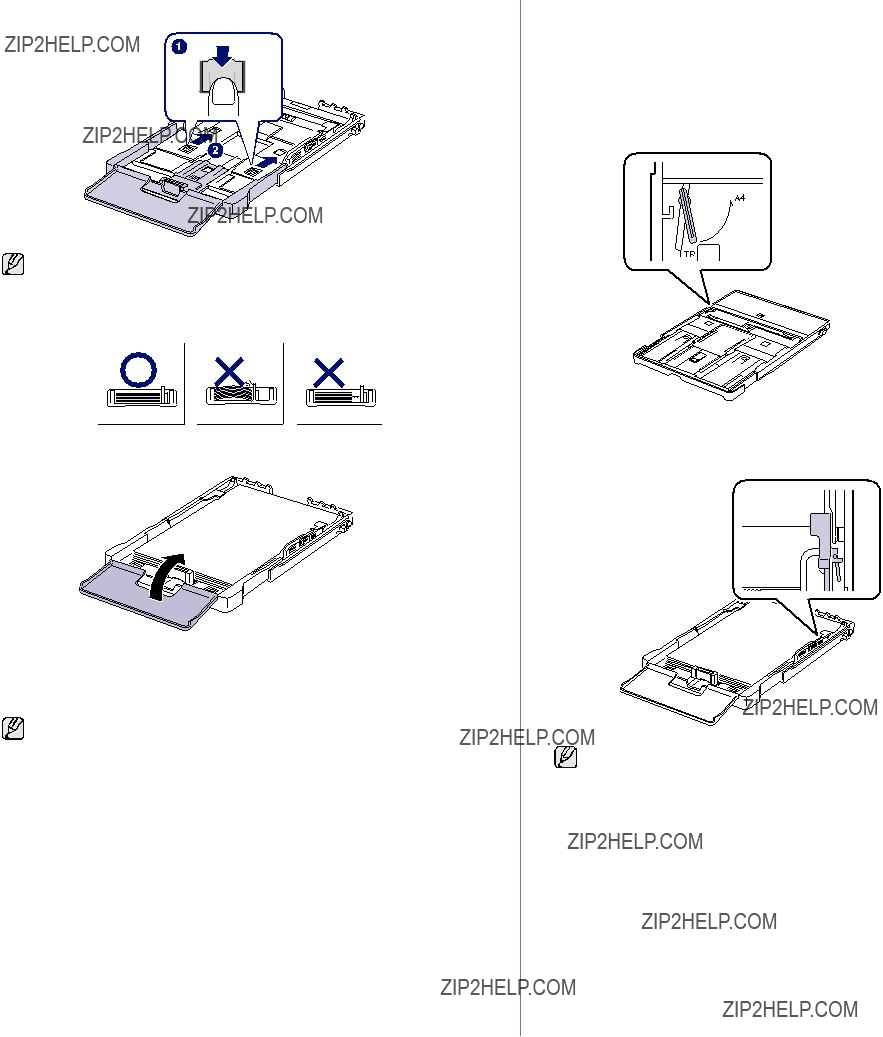
manually. Adjust the paper length guide and paper width guide.
??? Do not push the paper width guides far enough to cause the materials to warp.
???If you do not adjust the paper width guides, it may cause paper jams.
5.Close the paper cover.
6.Slide the tray back into the machine until it clicks.
7.After loading paper, set the paper type and size for the tray. See "Setting the paper size and type" on page 33.
??? If you experience problems with paper feed, place one sheet at a time in the tray.
???You can load previously printed paper. The printed side should be facing up with an uncurled edge at the rear. If you experience problems with paper feed, turn the paper around. Note that print quality is not guaranteed.
The tray is preset to Letter or A4 size, depending on your country. To change the size to A4 or Letter, you must adjust the lever and paper width guide properly.
1Pull the tray out of the machine. Open the paper cover and remove paper from the tray if necessary.
2If you want to change the size to Letter, hold the lever at the back of the tray, and rotate the lever clockwise.
3 Squeeze the paper width guide and slide it to the edge of the lever.
If you want to change the size to A4, first move the paper width guide to left and rotate the lever counterclockwise. If you force the lever, it could damage the tray.
32 _Selecting and loading print media

PRINTING ON SPECIAL PRINT MATERIALS
The machine can hold special sizes and types of print material, such as postcards, note cards, and envelopes. Especially, it is useful for single page printing on letterhead or colored paper.
Feeding the print material manually
???Load only one size of print media at a time in the tray.
???To prevent paper jams, do not add paper when there is still paper in the tray. This also applies to other types of print media.
???Print media should be loaded face up with the side you want to print, and the top edge going into the tray first. Place print materials in the center of the tray.
???Always load only the specified print media to avoid paper jams and print quality problems. (See "Selecting print media" on page 28.)
???Flatten any curl on postcards, envelopes, and labels before loading them into the tray.
1.Load the paper. (See "Changing the size of the paper in the paper tray" on page 31.)
Depending on the media type you are using, keep the following loading guidelines:
???Envelopes: Flap side down and with the stamp area on the top left side.
???Labels: Print side up and top short edge entering the machine first.
???Preprinted paper: Design side up with the top edge toward the machine.
???Card stock: Print side up and the short edge entering the machine first.
???Previously printed paper: Previously printed side down with an uncurled edge toward the machine.
2.When you print in application, start the print menu.
3.Before you print, open printer properties.
4.Press the Paper tab in printer properties, and select an appropriate paper type.
If you want to use an label, set the paper type to Label.
5.Select Manual Feeder in paper source then, press OK.
6.Start printing in application.
7.Press the  Stop button on the machine to start feeding then the machine starts printing.
Stop button on the machine to start feeding then the machine starts printing.
??? If you are printing multiple pages, load the next sheet after first
page prints out, and press the  Stop button. Repeat this step for every page to be printed.
Stop button. Repeat this step for every page to be printed.
???The settings you change remain in effect only while you are using the current application.
ADJUSTING THE OUTPUT SUPPORT
The printed pages stack on the output tray, and the output support will help the printed pages align. To let the output support correctly align the pages you need to pull it out appropriately depending on the paper size.
1 Output support
??? If the output support is incorrectly adjusted, printed pages may be
???If you continuously print many pages, the surface of the output tray may become hot. Be careful not to touch the surface, and especially keep children away from the surface.
SETTING THE PAPER SIZE AND TYPE
After loading paper in the paper tray, you need to set the paper size and type using the printer driver. Follow these steps to make your changes permanent.
The following procedure is for Windows XP. For other Windows OS, refer to the corresponding Windows User's Guide or online help.
1.Click the Start button on the computer screen.
2.Select Printers and Faxes.
3.
4.Click the Paper tab, and change the settings on Paper Options.
5.Click OK.
Selecting and loading print media_ 33
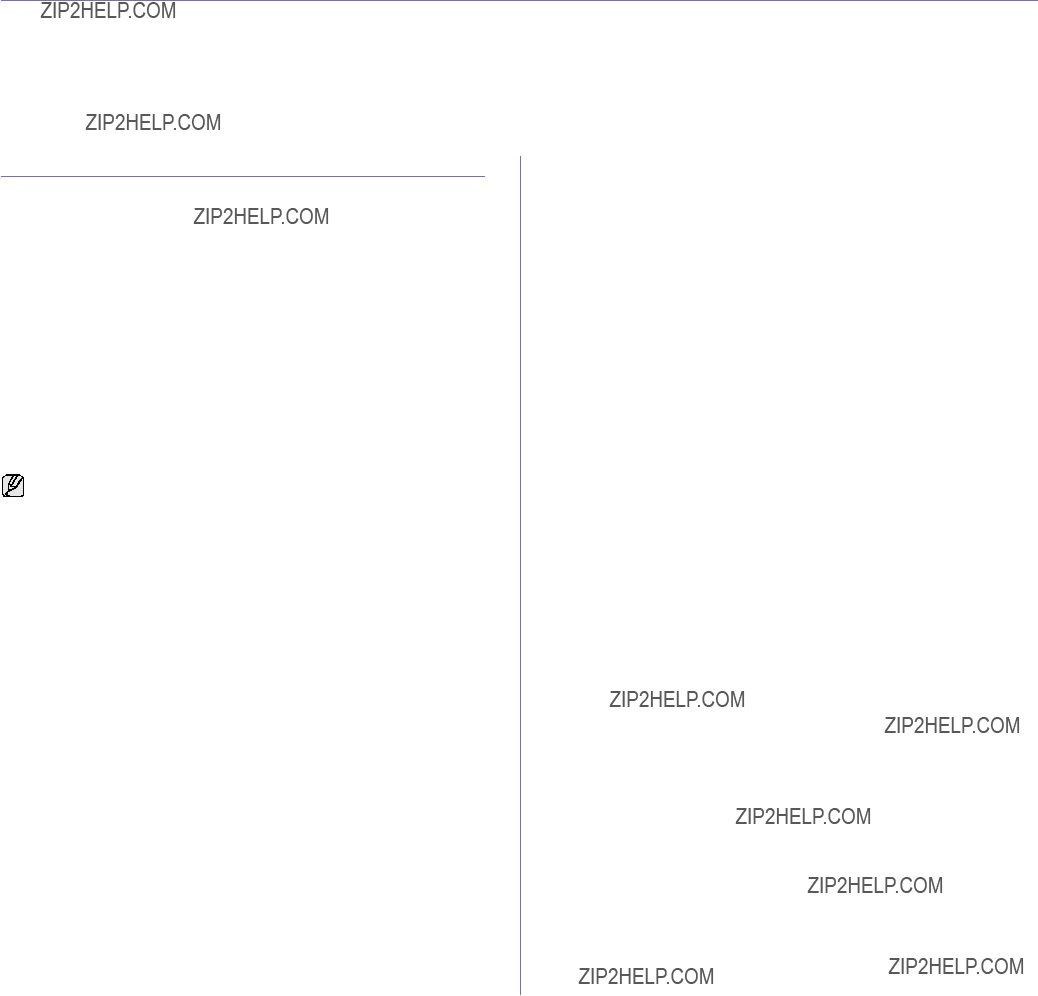
basic printing
This chapter explains common printing tasks.
PRINTING A DOCUMENT
Your machine allows you to print from various Windows, Macintosh, or Linux applications. The exact steps for printing a document may vary depending on the application you use.
For details about printing, see the Software secion.
CANCELING A PRINT JOB
If the print job is waiting in a print queue or print spooler, such as the printer group in Windows, delete the job as follows:
1. Click the Windows Start menu.
2. For Windows 2000, select Settings and then Printers. For Windows XP/2003, select Printers and Faxes.
For Windows Vista, select Control Panel > Hardware and Sound >
Printers.
3.
You can also access this window by simply
You can also cancel the current job by pressing  Stop on the control panel.
Stop on the control panel.
Basic printing_ 34

maintenance
This chapter provides information for maintaining your machine and the toner cartridge.
This chapter includes:
???Replacing the toner cartridge
PRINTING REPORTS
You can print a configuration report from the machine???s control panel. Use the configuration page to view the current settings, to help troubleshoot
problems. In Ready mode, press and hold the  Stop button on the control panel for about 5 seconds.
Stop button on the control panel for about 5 seconds.
CLEANING YOUR MACHINE
To maintain print quality, follow the cleaning procedures below each time the toner cartridge is replaced or if print quality problems occur.
???Cleaning the cabinet of the machine with cleaning materials containing large amounts of alcohol, solvent, or other strong substances can discolor or distort the cabinet.
???If your machine or its surrounding is contaminated with toner, we recommend you to use cloth or tissue dampened with water to clean it. If you use a vacuum cleaner, toner blown into the air may be harmful.
Cleaning the outside
Clean the cabinet of the machine with a soft
Cleaning the inside
During the printing process, paper, toner, and dust particles can accumulate inside the machine. This buildup can cause print quality problems, such as toner specks or smearing. Cleaning the inside of the machine clears or reduces these problems.
1.Turn the machine off and unplug the power cord. Wait for the machine to cool down.
2.Press the release button, completely open the front cover.
???Replacing the waste toner container
???Managing your machine from the website
3.Grasp the handles on the toner cartridge and pull to remove the cartridge from the machine.
4. Pull the waste toner container out of the machine using its handle.
35 _Maintenance
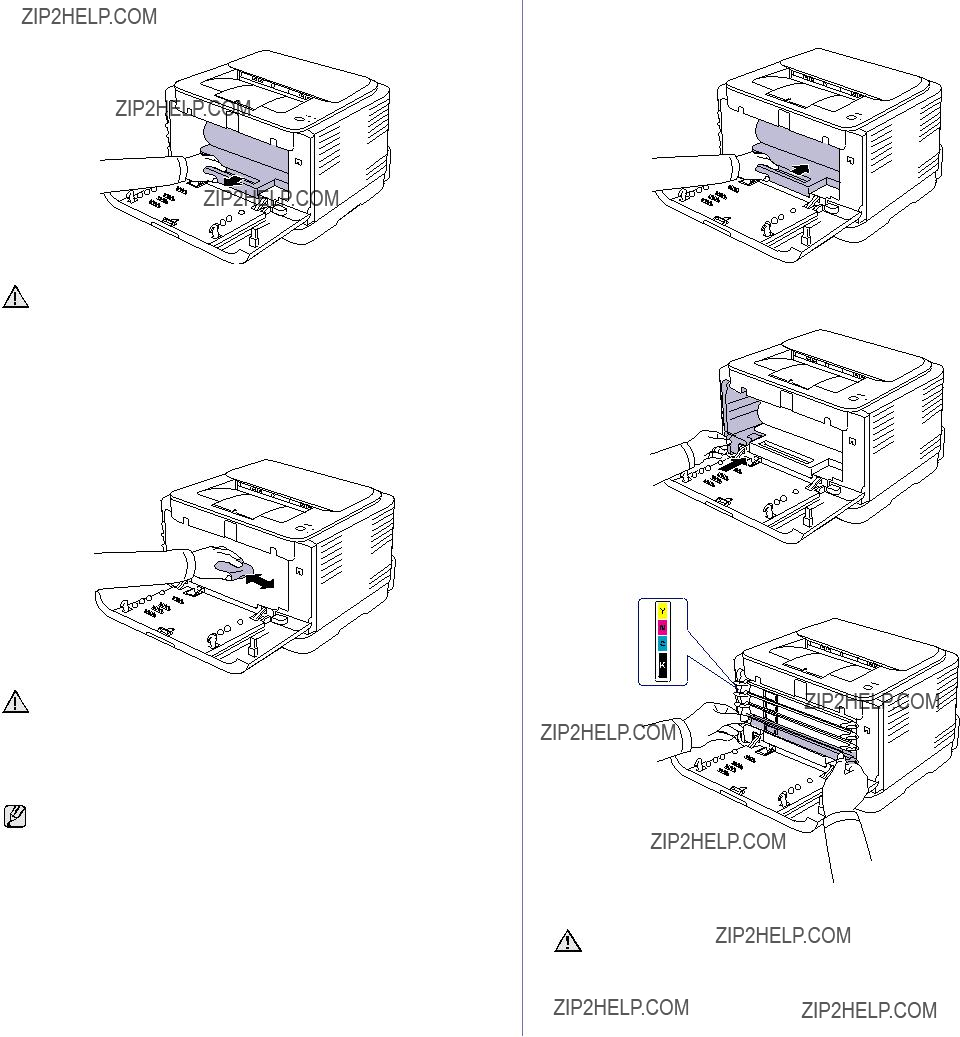
5.Pull the imaging unit out of the machine using the groove on the front of the imaging unit.
???Do not touch the green surface on the imaging unit with your hands or any other material.
???Be careful not to scratch the surface of the imaging unit.
???If you leave the front cover open for more than a few minutes, the imaging unit can be exposed to light. This will cause damage to the imaging unit. Close the front cover should the installation need to be halted for any reason.
6.With a dry
???If toner gets on your clothing, wipe it off with a dry cloth and wash it in cold water. Hot water sets toner into fabric.
???If your machine or its surrounding is contaminated with toner, we recommend you to use a cloth or tissue dampened with water to clean it. If you use a vacuum cleaner, toner blows into the air then might be harmful to you.
After cleaning, let the machine to dry completely.
7.Holding the groove on the front of the imaging unit, push imaging unit in to the machine.
8.Insert the waste toner container into position and then push it to make sure that it is firmly seated in place.
9. Slide the toner cartridge back into the machine.
10.Reinstall all the compartments into the machine, and close the front cover.
If the front cover is not completely closed, the machine will not operate.
11. Plug in the power cord and turn the machine on
36 _Maintenance

MAINTAINING THE CARTRIDGE
Toner cartridge storage
To get the most from the toner cartridge, keep the following guidelines in mind:
???Do not remove the toner cartridge from its package until ready for use.
???Do not refill the toner cartridge. The machine warranty does not cover damage caused by using a refilled cartridge.
???Store toner cartridges in the same environment as your machine.
???To prevent damage to the toner cartridge, do not expose it to light for more than a few minutes.
Estimated Cartridge Life
Expected Cartridge Life (the life of the toner cartridge yield) depends on the amount of toner that print jobs require. The actual
Redistributing toner
It is possible that colored images may be printed with incorrect colors due to flawed mixing of toner colors when one of the colored toner cartridges is low on toner. You can temporarily improve print quality by redistributing the toner.
???The SmartPanel program window appears on the computer telling you which color cartridge is low on toner.
1. Press the release button, completely open the front cover.
2.Grasp the handles on the toner cartridge and pull to remove the cartridge from the machine.
3.Holding both handles on the toner cartridge, thoroughly rock it from side to side to evenly distribute the toner.
If toner gets on your clothing, wipe it off with a dry
cloth and wash it in cold water. Hot water sets toner into fabric.
4. Slide the toner cartridge back into the machine.
5. Close the front cover. Make sure the cover is securely latched.
If the front cover is not completely closed, the machine will not operate.
Maintenance_ 37

REPLACING THE TONER CARTRIDGE
The machine uses four colors and has a different toner cartridge for each one: yellow (Y), magenta (M), cyan (C), and black (K).
When the toner colors LED, on the control panel, indicating each individual toner cartridge according to its color, lights, and the status LED lights red, the machine cartridge is totally exhausted. Your machine stops printing. Also, the Smart Panel program window appears on the computer telling you to replace the cartridge.
At this stage, the toner cartridge needs to be replaced. Check the type of toner cartridge for your machine. (See "Supplies" on page 50.)
Samsung does not recommend using
1.Turn the machine off, then wait a few minutes for the machine to cool.
2.Press the release button, completely open the front cover.
3.Grasp the handles on the toner cartridge and pull to remove the cartridge from the machine.
4.Holding both handles on the toner cartridge, thoroughly rock it from side to side to evenly distribute the toner.
5. Take a new toner cartridge out of its package.
??? Don't use sharp objects, such as a knife or scissors, to open the toner cartridge package. You could damage the surface of the toner cartridge.
???To prevent damage, do not expose the toner cartridge to light for more than a few minutes. Cover it with a piece of paper to protect it if necessary.
6.Place the toner cartridge on a flat surface, as shown, and remove the protecting cover.
If toner gets on your clothing, wipe it off with a dry cloth and wash it in cold water. Hot water sets toner into fabric.
7.Make sure that the color of the toner cartridge matches the color slot and then grasp the handles on the toner cartridge. Insert the cartridge until it clicks into place.
8.Close the front cover. Make sure the cover is securely latched, and then turn the machine on.
If the front cover is not completely closed, the machine will not operate.
38 _Maintenance
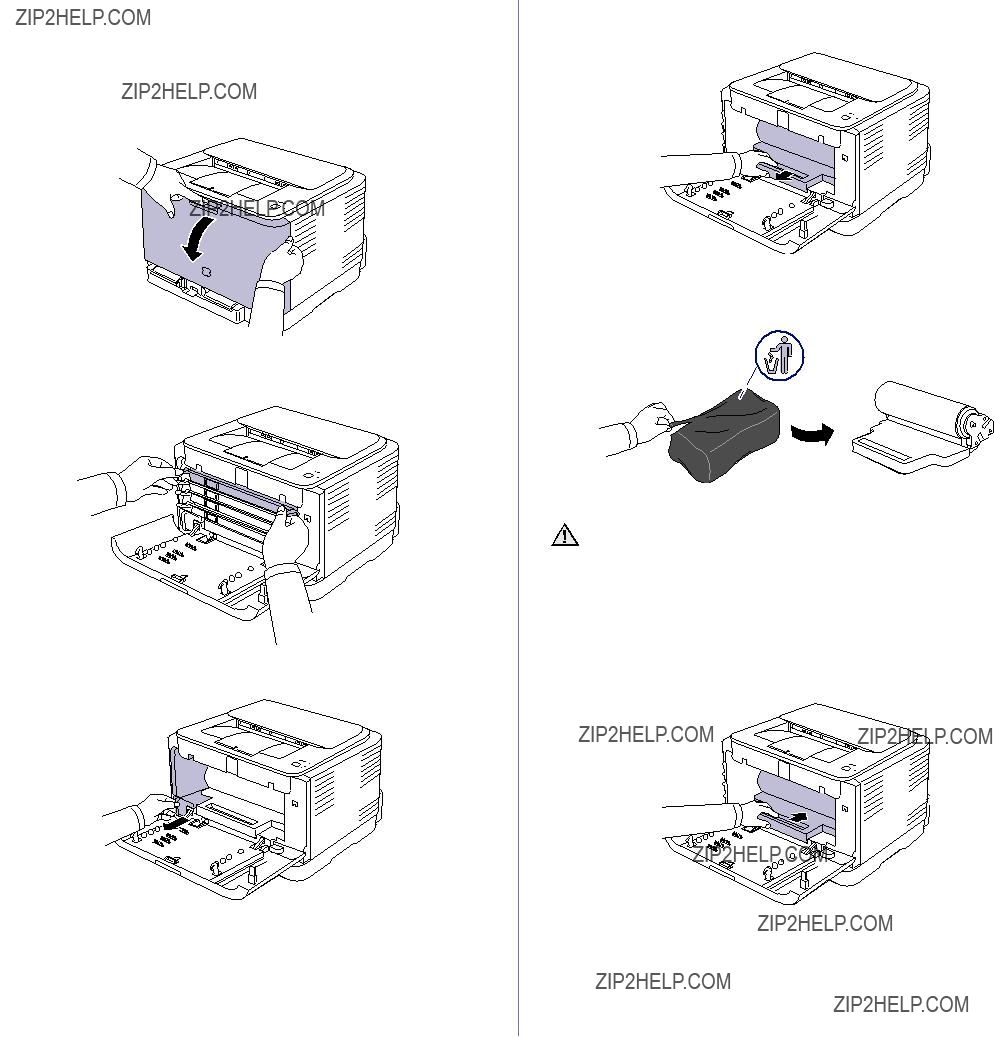
REPLACING THE IMAGING UNIT
When the life span of the imaging unit has expired, the Smart Panel program window appears on the computer, indicating the imaging unit needs to be replaced. Otherwise your machine stops printing.
1.Turn the machine off, then wait a few minutes for the machine to cool.
2.Press the release button, completely open the front cover.
3.Grasp the handles on the toner cartridge and pull to remove the cartridge from the machine.
4. Pull the waste toner container out of the machine using its handle.
5.Pull the imaging unit out of the machine using the groove on the front of the imaging unit.
6. Take a new imaging unit out of its package.
??? Don???t use sharp objects, such as a knife or scissors, to open the imaging unit package. You could damage the surface of the imaging unit.
???Be careful not to scratch the surface of the imaging unit.
???To prevent damage, do not expose the imaging unit to light for more than a few minutes. Cover it with a piece of paper to protect it if necessary.
7.Holding the groove on the front of the imaging unit, push imaging unit in to the machine.
Maintenance_ 39
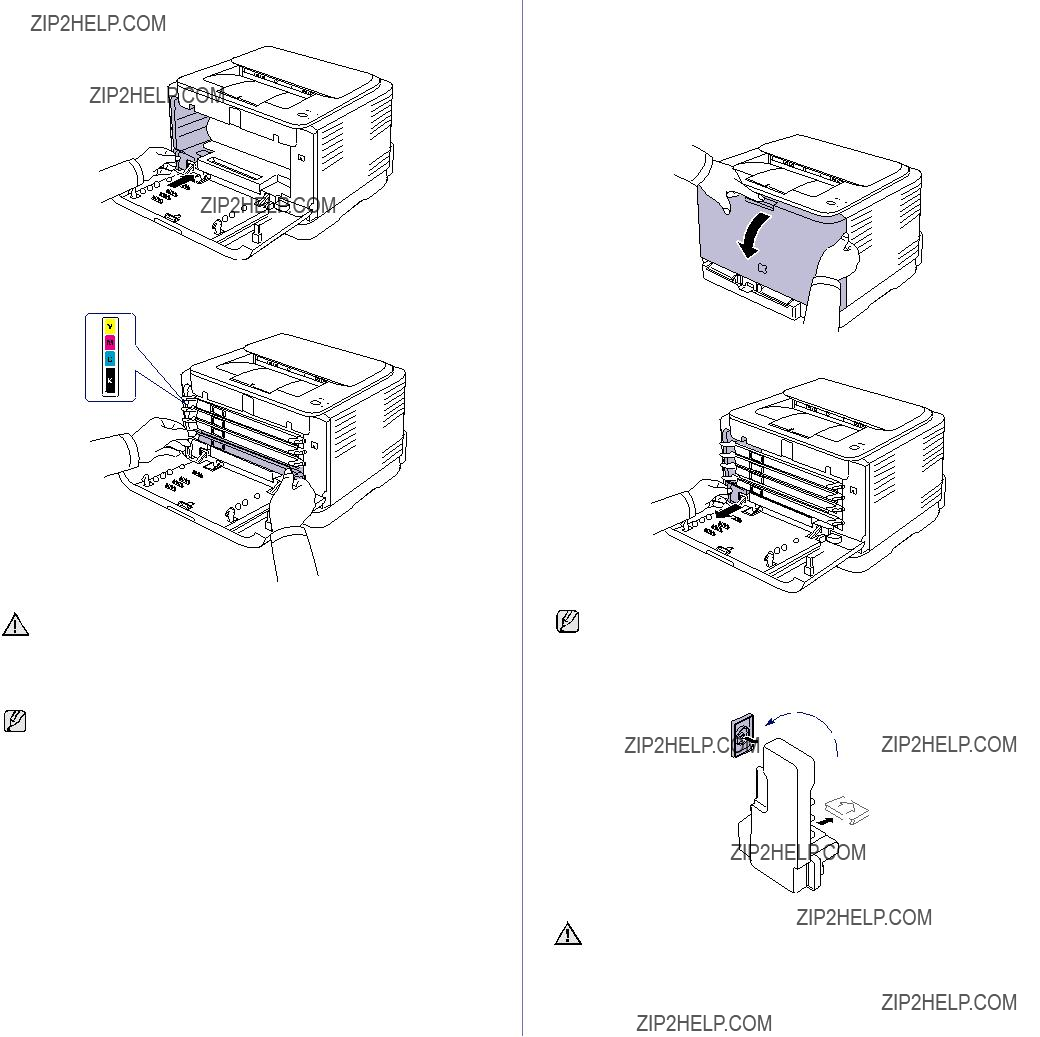
8.Insert the waste toner container into position and then push it to make sure that it is firmly seated in place.
9. Slide the toner cartridge back into the machine.
10. Close the front cover firmly.
If the front cover is not completely closed, the machine will not operate. Please make sure all toner cartridges are installed properly. If any toner cartridge is installed improperly, the front cover do not close.
11. Turn the machine on.
Each LED blinks red in a repeated order. Wait for about 1.5 minutes for your machine to get ready.
REPLACING THE WASTE TONER CONTAINER
When the life span of the waste toner container has expired, the Smart Panel program window appears on the computer, indicating the waste toner container needs to be replaced. Otherwise your machine stops printing.
1.Turn the machine off, then wait a few minutes for the machine to cool.
2.Open the front cover.
3. Pull the waste toner container out of the machine using its handle.
Make sure that you lay the waste toner container on a flat surface so that the toner does not spill.
4.Remove the container???s cap from the container as shown below, and use it to close the waste toner container opening.
Do not tilt or turn over the container.
5. Take a new waste toner container out of its package.
40 _Maintenance

6.Insert the new container into position and then push it to make sure that it is firmly seated in place.
7. Close the front cover firmly.
If the front cover is not completely closed, the machine will not operate. Please make sure all toner cartridges are installed properly. If any toner cartridge is installed improperly, the front cover do not close.
8. Turn the machine on.
MAINTENANCE PARTS
To avoid print quality and paper feed problems resulting from worn parts, and to maintain your machine in top working condition the following condition, the following items will need to be replaced after the specified number of pages, or when the life span of each item has expired.
We highly recommend that this maintenance be performed by an authorized service provider, dealer or the retailer where you bought the machine. The warranty does not cover the replacement of the maintenance parts after their lifespan.
MANAGING YOUR MACHINE FROM THE
WEBSITE
If you have connected your machine to a network and set up TCP/IP network parameters correctly, you can manage the machine via Samsung???s
SyncThru??? Web Service, an embedded web server. Use SyncThru??? Web Service to:
???View the machine???s device information and check its current status.
???Change TCP/IP parameters and set up other network parameters.
???Change the printer properties.
???Set the machine to send email notifications to let you know the machine???s status.
???Get support for using the machine.
To access SyncThru??? Web Service:
1.Start a web browser, such as Internet Explorer, from Windows.
2.Enter the machine IP address (http://xxx.xxx.xxx.xxx) in the address field and press the Enter key or click Go.
Your machine???s embedded website opens.
Maintenance_ 41

troubleshooting
This chapter gives helpful information for what to do if you encounter an error.
This chapter includes:
???Tips for avoiding paper jams
TIPS FOR AVOIDING PAPER JAMS
By selecting the correct media types, most paper jams can be avoided. When a paper jam occurs, follow the steps outlined on page 42.
???Follow the procedures on page 31. Ensure that the adjustable guides are positioned correctly.
???Do not overload the tray. Ensure that the paper level is below the paper capacity mark on the inside of the tray.
???Do not remove paper from the tray while your machine is printing.
???Flex, fan, and straighten paper before loading.
???Do not use creased, damp, or highly curled paper.
???Do not mix paper types in a tray.
???Use only recommended print media. (See "Setting the paper size and type" on page 33.)
???Ensure that the recommended side of the print media is facing up in the tray.
CLEARING PAPER JAMS
To avoid tearing the paper, pull the jammed paper out gently and slowly. Follow the instructions in the following sections to clear the jam.
If a paper jam occurs, the status LED on the control panel lights red. Find and remove the jammed paper.
To resume printing after clearing paper jams, you must open and close the front cover or rear cover.
If paper is jammed in the paper feed area, follow the next steps to release the jammed paper.
1. Pull the tray out of the printer and remove the jammed paper.
2. To remove the jammed paper, open the rear cover.
3.Carefully remove the paper by pulling in the direction as shown below. Most of the jammed paper can be removed in this step.
If you cannot find the jammed paper, or if there is any resistance removing the paper, stop pulling and go to the next step.
If the paper tears, make sure that all of the paper fragments are removed from the printer.
If you cannot find the jammed paper, go to the next step.
Troubleshooting_ 42

4. Push the fuser levers upwards.
1 fuser lever
5. Open the top cover and inner cover.
6.Holding the inner cover open, carefully take the jammed paper out of the printer. The inner cover will then close automatically.
Do not touch the fuser inside the inner cover. It is hot and could cause burns! The fuser???s operating temperature is 180 ??C (356 ??F). Take care when removing paper from the printer.
7. Close the top cover. Make sure that it is securely closed.
8. Push the fuser levers downwards.
9. Open and then close the rear cover or front cover to resume printing.
Troubleshooting_ 43

SOLVING OTHER PROBLEMS
The following chart lists some conditions that may occur and the recommended solutions. Follow the suggested solutions until the problem is corrected. If the problem persists, call for service.
Paper feeding
Printing problems
???Check the machine for the following:
???The front cover is not closed. Close the cover.
???Paper is jammed. Clear the paper jam. See page 42.
???No paper is loaded. Load paper. See page 31.
???The toner cartridge is not installed. Install the toner cartridge.
???If a system error occurs, contact your service representative.
44 _Troubleshooting

Printing quality problems
If the inside of the machine is dirty or paper has been loaded improperly, you may notice a reduction in print quality. See the table below to clear the problem.
Light or faded print If a vertical white streak or faded area appears on the page:
???The toner supply is low. You may be able
to temporarily extend the toner cartridge life. See page 38. If this does not improve the print quality, install a new toner cartridge.
???The paper may not meet paper
specifications; for example, the paper is too moist or too rough. See page 28.
???If the entire page is light, the print resolution setting is too low. Adjust the print resolution. See the help screen of the printer driver.
???A combination of faded or smeared defects may indicate that the toner cartridge needs cleaning.
???The surface of the LSU part inside the machine may be dirty. Clean the LSU by opening and closing the front cover several times and if the problem still occurs call the contact a service representative.
Troubleshooting_ 45

???Change the printer option and try again. Go to printer properties, click Paper tab, and set type to Thick Paper. Refer to the
Software section for details.
If these steps do not correct the problem, contact a service representative.
???If background scatter covers the entire surface area of a printed page, adjust the print resolution through your software application or the printer properties.
46 _Troubleshooting

Wrinkles or creases ??? Ensure that the paper is loaded properly.
???Check the paper type and quality. See page 28.
???Turn over the stack of paper in the tray. Also
try rotating the paper 180?? in the tray.
???Turn over the stack of paper in the tray.
Also try rotating the paper 180?? in the tray.
??? Change the printer option and try again. Go to printer properties, click Paper tab, and set type to Thin Paper. Refer to the
Software section for details.
Troubleshooting_ 47
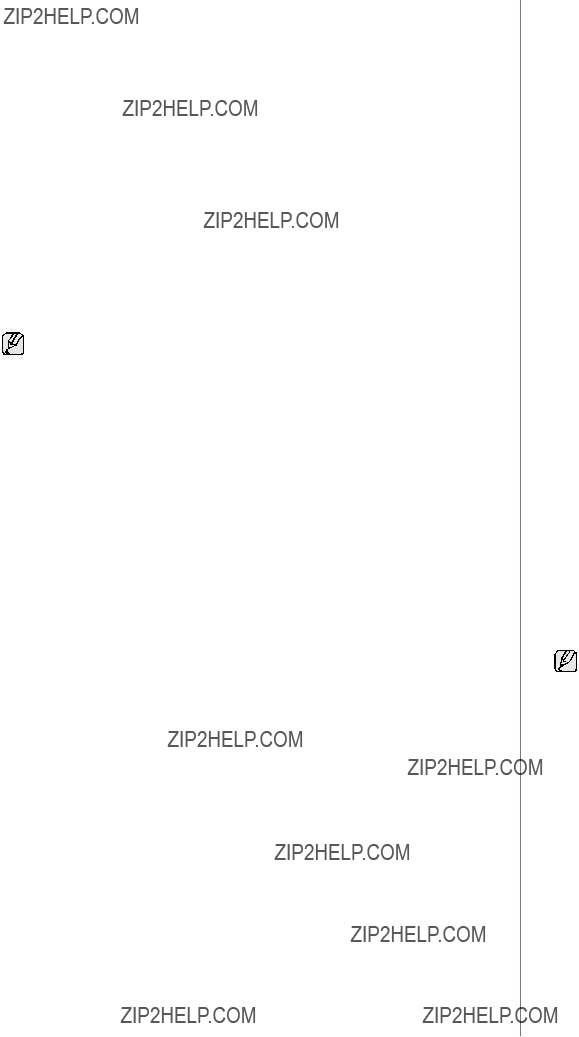
Common Windows problems
Refer to the Microsoft Windows documentation that came with your computer for further information on Windows error messages.
Common Linux problems
Refer to Linux User???s Guide that came with your computer for further information on Linux error messages.
48 _Troubleshooting

Common Macintosh problems
Refer to Mac OS User???s Guide that came with your computer for further information on Mac OS error messages.
Troubleshooting_ 49
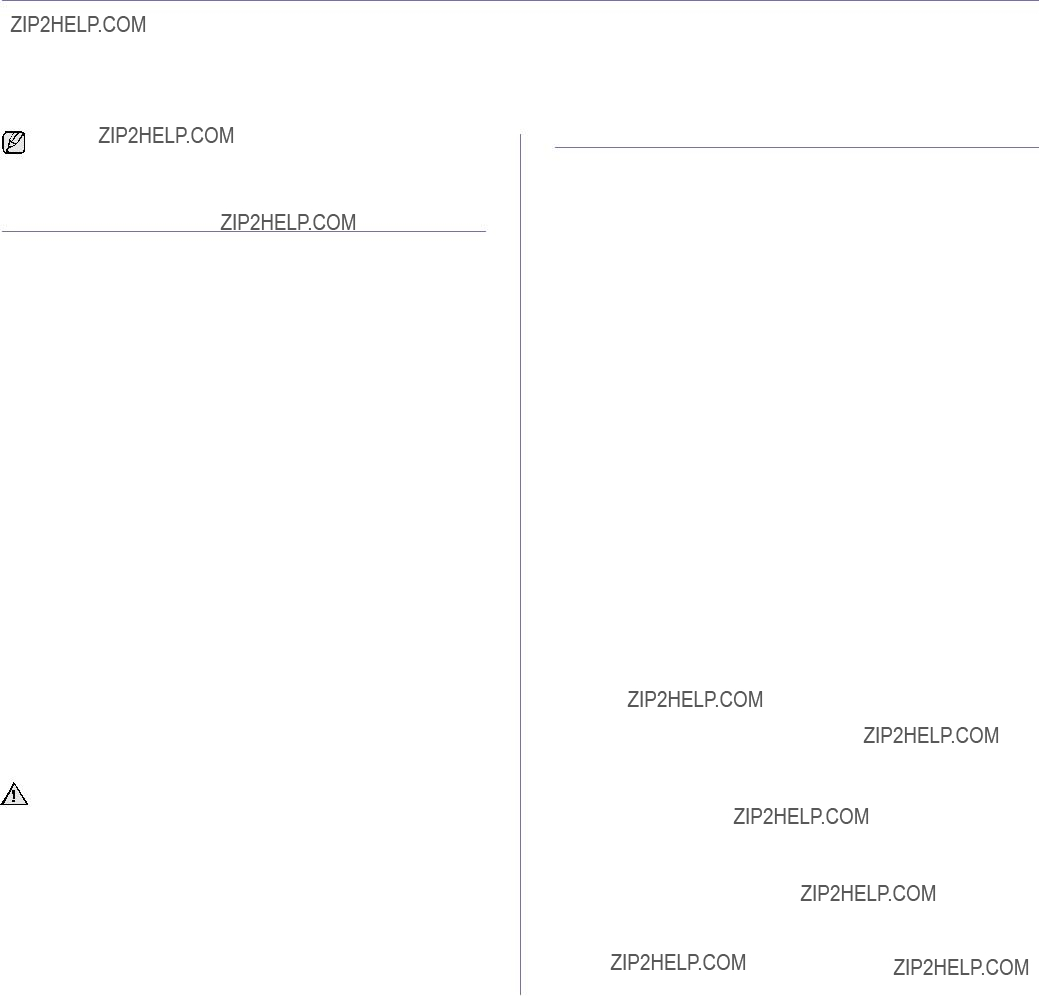
ordering supplies and accessories
This chapter provides information on purchasing cartridges and accessories available for your machine.
This chapter includes:
???Supplies
The optional parts or features may differ by countries. Contact your sales representatives whether the part you want is available in your country.
SUPPLIES
When the toner runs out, you can order the following type of toner cartridge for your machine:
a.Declared yield value in accordance with ISO/IEC 19798.
b.Region A:Albania, Austria, Belgium, Bosnia, Bulgaria, Croatia, Cyprus, Czech Republic, Denmark, Finland, France, Germany, Greece, Hungary, Italy, Macedonia, Netherlands, Norway, Poland, Portugal, Romania, Serbia, Slovakia, Slovenia, Spain, Sweden, Switzerland, UK,
c.Image counts based on one color on each page. If you print documents in full color (Cyan, Magenta, Yellow, Black), the life of this item will be reduced by 25%.
When you purchase a new toner cartridge or supplies, you must purchase them in the same country you have purchased your machine.
Otherwise, the toner cartridge or supplies will be incompatible with your machine since the configuration of the toner cartridge or supplies vary depending on the countries.
HOW TO PURCHASE
To order
Ordering supplies and accessories_ 50

specifications
This chapter guides you about this machine???s specifications such as various features.
This chapter include:
GENERAL SPECIFICATIONS
The symbol * optional feature depending on machines.
a.Sound Pressure Level, ISO 7779
b.Declared yield value in accordance with ISO/IEC 19798. The number of pages may be affected by operating environment, printing interval, media type, and media size.
c.Image counts based on one color on each page. If you print documents in full color (Black, Cyan, Magenta, Yellow), the life of this item will be reduced by 25%.
51 _Specifications

PRINTER SPECIFICATIONS
???
???
LAN
a.It will be affected by operating system used, computing performance, application software, connecting method, media type, media size and job complexity.
b.Visit www.samsungprinter.com to download the latest software version.
52 _Specifications

glossary
The following glossary helps you get familiar with the product by understanding the terminologies commonly used with printing as well as mentioned in this user's guide.
ADF
An Automatic Document Feeder (ADF) is a mechanism that will automatically feed an original sheet of paper so that the machine can scan some amount of the paper at once.
AppleTalk
AppleTalk is a proprietary suite of protocols developed by Apple, Inc for computer networking. It was included in the original Macintosh (1984) and is now deprecated by Apple in favor of TCP/IP networking.
BIT Depth
A computer graphics term describing the number of bits used to represent the color of a single pixel in a bitmapped image. Higher color depth gives a broader range of distinct colors. As the number of bits increases, the number of possible colors becomes impractically large for a color map.
BMP
A bitmapped graphics format used internally by the Microsoft Windows graphics subsystem (GDI), and used commonly as a simple graphics file format on that platform.
BOOTP
Bootstrap Protocol. A network protocol used by a network client to obtain its IP address automatically. This is usually done in the bootstrap process of computers or operating systems running on them. The BOOTP servers assign the IP address from a pool of addresses to each client. BOOTP enables 'diskless workstation' computers to obtain an IP address prior to loading any advanced operating system.
CCD
Charge Coupled Device (CCD) is a hardware which enables the scan job. CCD Locking mechanism is also used to hold the CCD module to prevent any damage when you move the machine.
Collation
Collation is a process of printing a
Control Panel
A control panel is a flat, typically vertical, area where control or monitoring instruments are displayed. They are typically found in front of the machine.
Coverage
It is the printing term used for a toner usage measurement on printing. For example, 5% coverage means that an A4 sided paper has about 5% image or text on it. So, if the paper or original has complicated images or lots of text on it, the coverage will be higher and at the same time, a toner usage will be as much as the coverage.
CSV
Comma Separated Values (CSV). A type of file format, CSV is used to exchange data between disparate applications. The file format, as it is used in Microsoft Excel, has become a pseudo standard throughout the industry, even among
DADF
A Duplex Automatic Document Feeder (DADF) is a mechanism that will automatically feed and flip over an original sheet of paper so that the machine can scan on both sides of the paper.
Default
The value or setting that is in effect when taking a printer out of its box state, reset, or initialized.
DHCP
A Dynamic Host Configuration Protocol (DHCP) is a
DIMM
Dual Inline Memory Module (DIMM), a small circuit board that holds memory. DIMM stores all the data within the machine like printing data, received fax data.
DNS
The Domain Name Server (DNS) is a system that stores information associated with domain names in a distributed database on networks, such as the Internet.
Dot Matrix Printer
A dot matrix printer refers to a type of computer printer with a print head that runs back and forth on the page and prints by impact, striking an
DPI
Dots Per Inch (DPI) is a measurement of resolution that is used for scanning and printing. Generally, higher DPI results in a higher resolution, more visible detail in the image, and a larger file size.
DRPD
Distinctive Ring Pattern Detection. Distinctive Ring is a telephone company service which enables a user to use a single telephone line to answer several different telephone numbers.
Duplex
A mechanism that will automatically flip over a sheet of paper so that the machine can print (or scan) on both sides of the paper. A printer equipped with a Duplex can print
Duty Cycle
Duty cycle is the page quantity which does not affect printer performance for a month. Generally the printer has the lifespan limitation such as pages per year. The lifespan means the average capacity of
ECM
Error Correction Mode (ECM) is an optional transmission mode built into Class 1 fax machines or fax modems. It automatically detects and corrects errors in the fax transmission process that are sometimes caused by telephone line noise.
Emulation
Emulation is a technique of one machine obtaining the same results as another.
53 _Glossary

An emulator duplicates the functions of one system with a different system, so that the second system behaves like the first system. Emulation focuses on exact reproduction of external behavior, which is in contrast to simulation, which concerns an abstract model of the system being simulated, often considering its internal state.
Ethernet
Ethernet is a
EtherTalk
A suite of protocols developed by Apple Computer for computer networking. It was included in the original Macintosh (1984) and is now deprecated by Apple in favor of TCP/IP networking.
FDI
Foreign Device Interface (FDI) is a card installed inside the machine to allow a third party device such as a coin operated device or a card reader. Those devices allow the
FTP
A File Transfer Protocol (FTP) is a commonly used protocol for exchanging files over any network that supports the TCP/IP protocol (such as the Internet or an intranet).
Fuser Unit
The part of a laser printer that melts the toner onto the print media. It consists of a hot roller and a
Gateway
A connection between computer networks, or between a computer network and a telephone line. It is very popular, as it is a computer or a network that allows access to another computer or network.
Grayscale
A shades of gray that represent light and dark portions of an image when color images are converted to grayscale; colors are represented by various shades of gray.
Halftone
An image type that simulates grayscale by varying the number of dots. Highly colored areas consist of a large number of dots, while lighter areas consist of a smaller number of dots.
HDD
Hard Disk Drive (HDD), commonly referred to as a hard drive or hard disk, is a
IEEE
The Institute of Electrical and Electronics Engineers (IEEE) is an international
IEEE 1284
The 1284 parallel port standard was developed by the Institute of Electrical and Electronics Engineers (IEEE). The term
Intranet
A private network that uses Internet Protocols, network connectivity, and possibly the public telecommunication system to securely share part of an organization's information or operations with its employees.
Sometimes the term refers only to the most visible service, the internal website.
IP address
An Internet Protocol (IP) address is a unique number that devices use in order to identify and communicate with each other on a network utilizing the Internet Protocol standard.
IPM
The Images Per Minute (IPM) is a way of measuring the speed of a printer. An IPM rate indicates the number of
IPP
The Internet Printing Protocol (IPP) defines a standard protocol for printing as well as managing print jobs, media size, resolution, and so forth. IPP can be used locally or over the Internet to hundreds of printers, and also supports access control, authentication, and encryption, making it a much more capable and secure printing solution than older ones.
IPX/SPX
IPX/SPX stands for Internet Packet Exchange/Sequenced Packet Exchange. It is a networking protocol used by the Novell NetWare operating systems. IPX and SPX both provide connection services similar to TCP/IP, with the IPX protocol having similarities to IP, and SPX having similarities to TCP. IPX/SPX was primarily designed for local area networks (LANs), and is a very efficient protocol for this purpose (typically its performance exceeds that of TCP/IP on a LAN).
ISO
The International Organization for Standardization (ISO) is an international
The International Telecommunication Union is an international organization established to standardize and regulate international radio and telecommunications. Its main tasks include standardization, allocation of the radio spectrum, and organizing interconnection arrangements between different countries to allow international phone calls. A
Standardized test chart published by
JBIG
Joint
JPEG
Joint Photographic Experts Group (JPEG) is a most commonly used standard method of lossy compression for photographic images. It is the format used for storing and transmitting photographs on the World Wide Web.
LDAP
The Lightweight Directory Access Protocol (LDAP) is a networking protocol for querying and modifying directory services running over TCP/ IP.
54 _Glossary

LED
A
MAC address
Media Access Control (MAC) address is a unique identifier associated with a network adapter. MAC address is a unique
MFP
Multi Function Peripheral (MFP) is an office machine that includes the following functionality in one physical body, so as to have a printer, a copier, a fax, a scanner and etc.
MH
Modified Huffman (MH) is a compression method for decreasing the amount of data that needs to be transmitted between the fax machines to transfer the image recommended by
MMR
Modified Modified READ (MMR) is a compression method recommended by
Modem
A device that modulates a carrier signal to encode digital information, and also demodulates such a carrier signal to decode transmitted information.
MR
Modified Read (MR) is a compression method recommended by
NetWare
A network operating system developed by Novell, Inc. It initially used cooperative multitasking to run various services on a PC, and the network protocols were based on the archetypal Xerox XNS stack. Today NetWare supports TCP/IP as well as IPX/SPX.
OPC
Organic Photo Conductor (OPC) is a mechanism that makes a virtual image for print using a laser beam emitted from a laser printer, and it is usually green or gray colored and a cylinder shaped.
An exposing unit of a drum is slowly worn away by its usage of the printer, and it should be replaced appropriately since it gets scratches from grits of a paper.
Originals
The first example of something, such as a document, photograph or text, etc, which is copied, reproduced or translated to produce others, but which is not itself copied or derived from something else.
OSI
Open Systems Interconnection (OSI) is a model developed by the International Organization for Standardization (ISO) for communications. OSI offers a standard, modular approach to network design that divides the required set of complex functions into manageable,
PABX
A private automatic branch exchange (PABX) is an automatic telephone switching system within a private enterprise.
PCL
Printer Command Language (PCL) is a Page Description Language (PDL) developed by HP as a printer protocol and has become an industry standard. Originally developed for early inkjet printers, PCL has been released in varying levels for thermal, matrix printer, and page printers.
Portable Document Format (PDF) is a proprietary file format developed by Adobe Systems for representing two dimensional documents in a device independent and resolution independent format.
PostScript
PostScript (PS) is a page description language and programming language used primarily in the electronic and desktop publishing areas. - that is run in an interpreter to generate an image.
Printer Driver
A program used to send commands and transfer data from the computer to the printer.
Print Media
The media like paper, envelopes, labels, and transparencies which can be used on a printer, a scanner, a fax or, a copier.
PPM
Pages Per Minute (PPM) is a method of measurement for determining how fast a printer works, meaning the number of pages a printer can produce in one minute.
PRN file
An interface for a device driver, this allows software to interact with the device driver using standard input/output system calls, which simplifies many tasks.
Protocol
A convention or standard that controls or enables the connection, communication, and data transfer between two computing endpoints.
PS
See PostScript.
PSTN
The
Resolution
The sharpness of an image, measured in Dots Per Inch (DPI). The higher the dpi, the greater the resolution.
SMB
Server Message Block (SMB) is a network protocol mainly applied to share files, printers, serial ports, and miscellaneous communications between nodes on a network. It also provides an authenticated Inter- process communication mechanism.
SMTP
Simple Mail Transfer Protocol (SMTP) is the standard for
Glossary_ 55

Subnet Mask
The subnet mask is used in conjunction with the network address to determine which part of the address is the network address and which part is the host address.
TCP/IP
The Transmission Control Protocol (TCP) and the Internet Protocol (IP); the set of communications protocols that implement the protocol stack on which the Internet and most commercial networks run.
TCR
Transmission Confirmation Report (TCR) provides details of each transmission such as job status, transmission result and number of pages sent. This report can be set to print after each job or only after failed transmissions.
TIFF
Tagged Image File Format (TIFF) is a
Toner Cartridge
A kind of bottle within a machine like printer which contains toner. Toner is a powder used in laser printers and photocopiers, which forms the text and images on the printed paper. Toner can be melted by the heat of the fuser, causing it to bind to the fibers in the paper.
TWAIN
An industry standard for scanners and software. By using a TWAIN- compliant scanner with a
UNC Path
Uniform Naming Convention (UNC) is a standard way to access network shares in Window NT and other Microsoft products. The format of a UNC path is: \\<servername>\<sharename>\<Additional directory>
URL
Uniform Resource Locator (URL) is the global address of documents and resources on the Internet. The first part of the address indicates what protocol to use, the second part specifies the IP address or the domain name where the resource is located.
USB
Universal Serial Bus (USB) is a standard that was developed by the USB Implementers Forum, Inc., to connect computers and peripherals. Unlike the parallel port, USB is designed to concurrently connect a single computer USB port to multiple peripherals.
Watermark
A watermark is a recognizable image or pattern in paper that appears lighter when viewed by transmitted light. Watermarks were first introduced in Bologna, Italy in 1282; they have been used by papermakers to identify their product, and also on postage stamps, currency, and other government documents to discourage counterfeiting.
WIA
Windows Imaging Architecture (WIA) is an imaging architecture that is originally introduced in Windows Me and Windows XP. A scan can be initiated from within these operating systems by using a
56 _Glossary

index
A
adjustment
altitude 27
C
cleaning
control panel 17
D
demo page, print 20
J
jam
tips for avoiding paper jams 42
L
LED
Status 18
Linux problems 48
M
Maintenance
maintenance parts 41 toner cartridge 37
N
network
setting up 21
P
paper
changing the size 31 clearing jam 42
printing special materials 33
paper type
setting 33
power save mode 27
print quality problems, solve 45 printing
Index_57
58_Index

contact SAMSUNG worldwide
If you have any comments or questions regarding Samsung products, contact the Samsung customer care center.
59 _Contact SAMSUNG worldwide
Contact SAMSUNG worldwide_ 60
?? 2008 Samsung Electronics Co., Ltd. All rights reserved.
This user???s guide is provided for information purposes only. All information included herein is subject to change without notice. Samsung Electronics is not responsible for any direct or indirect damages, arising from or related to use of this user???s guide.
???Samsung and Samsung logo are trademarks of Samsung Electronics Co., Ltd.
???Microsoft, Windows, and Windows Vista are either registered trademarks or trademarks of Microsoft Corporation.
???UFST?? and MicroType??? are registered trademarks of Monotype Imaging Inc.
???TrueType, LaserWriter and Macintosh are trademarks of Apple Computer, Inc.
???All other brand or product names are trademarks of their respective companies or organizations.


 Samsung Printer
Samsung Printer

 Software section
Software section
SOFTWARE SECTION
CONTENTS
Chapter 1: INSTALLING PRINTER SOFTWARE IN WINDOWS
Chapter 2: BASIC PRINTING
Chapter 3: ADVANCED PRINTING
2
3

1 Installing Printer
Software in Windows
This chapter includes:
???Installing Printer Software
???Changing the Software Language
???Reinstalling Printer Software
???Removing Printer Software
???Installing mono printer driver
NOTE: The following procedure is based on Windows XP, for other operating systems, refer to the corresponding Windows user's guide or online help.
Installing Printer Software
You can install the printer software for local printing or network printing. To install the printer software on the computer, perform the appropriate installation procedure depending on the printer in use.
A printer driver is software that lets your computer communicate with your printer. The procedure to install drivers may differ depending on the operating system you are using.
All applications should be closed on your PC before beginning installation.
Installing Software for Local Printing
A local printer is a printer directly attached to your computer using the printer cable supplied with your printer, such as a USB or parallel cable. If your printer is attached to a network, skip this step and go to ???Installing Software for Network Printing??? on page 7.
You can install the printer software using the typical or custom method.
NOTE: If the ???New Hardware Wizard??? window appears during the installation procedure, click  in the upper right corner of the box to close the window, or click Cancel.
in the upper right corner of the box to close the window, or click Cancel.
Typical Installation
This is recommended for most users. All components necessary for printer operations will be installed.
1Make sure that the printer is connected to your computer and powered on.
2Insert the supplied
The
If the installation window does not appear, click Start and then Run. Type X:\Setup.exe, replacing ???X??? with the letter which represents your drive and click OK.
If you use Windows Vista, click Start ???All programs ??? Accessories ???Run, and type X:\Setup.exe.
If the AutoPlay window appears in Windows Vista, click
Run Setup.exe in Install or run program field, and click Continue in the User Account Control window.
3Click Next.
???If necessary, select a language from the
???View User???s Guide: Allows you to view the User???s Guide. If your computer doesn???t have Adobe Acrobat, click on this option and it will automatically install Adobe Acrobat Reader for you.
4Select Typical installation for a local printer. Click Next.
4
Installing Printer Software in Windows

NOTE: If your printer is not already connected to the computer, the following window will appear.
???After connecting the printer, click Next.
???If you don???t want to connect the printer at this time, click Next, and No on the following screen. Then the installation will start and a test page will not be printed at the end of the installation.
???The installation window that appears in this User???s Guide may differ depending on the printer and interface in use.
5After the installation is finished, a window asking you to print a test page appears. If you choose to print a test page, select the checkbox and click Next.
Otherwise, just click Next and skip to step 7.
6If the test page prints out correctly, click Yes. If not, click No to reprint it.
7To register yourself as a user of Samsung Printers in order to receive information from Samsung, select the checkbox and click Finish. You are now sent to the Samsung web site.
Otherwise, just click Finish.
NOTE: After setup is complete, if your printer driver doesn???t work properly, reinstall the printer driver. See ???Reinstalling Printer Software??? on page 10.
Custom Installation
You can choose individual components to install.
1Make sure that the printer is connected to your computer and powered on.
2Insert the supplied
The
If the installation window does not appear, click Start and then Run. Type X:\Setup.exe, replacing ???X??? with the letter which represents your drive and click OK.
If you use Windows Vista, click Start ???All programs ??? Accessories ???Run, and type X:\Setup.exe.
If the AutoPlay window appears in Windows Vista, click
Run Setup.exe in Install or run program field, and click Continue in the User Account Control window.
3Click Next.
???If necessary, select a language from the
???View User???s Guide: Allows you to view the User???s Guide. If your computer doesn???t have Adobe Acrobat, click on this option and it will automatically install Adobe Acrobat Reader for you.
5
Installing Printer Software in Windows

4 Select Custom installation. Click Next.
5 Select your printer and click Next.
NOTE: If your printer is not already connected to the computer, the following window will appear.
???After connecting the printer, click Next.
???If you don???t want to connect the printer at this time, click Next, and No on the following screen. Then the installation will start and a test page will not be printed at the end of the installation.
???The installation window that appears in this User???s Guide may differ depending on the printer and interface in use.
6 Select the components to be installed and click Next.
NOTE: You can change the desired installation folder by clicking [Browse].
7After the installation is finished, a window asking you to print a test page appears. If you choose to print a test page, select the checkbox and click Next.
Otherwise, just click Next and skip to step 9.
8If the test page prints out correctly, click Yes. If not, click No to reprint it.
9To register yourself as a user of Samsung Printers in order to receive information from Samsung, select the checkbox and click Finish. You are now sent to the Samsung web site.
Otherwise, just click Finish.
6
Installing Printer Software in Windows

Installing Software for Network Printing
When you connect your printer to a network, you must first configure the TCP/IP settings for the printer. After you have assigned and verified the TCP/IP settings, you are ready to install the software on each computer on the network.
You can install the printer software using the typical or custom method.
Typical Installation
This is recommended for most users. All components necessary for printer operations will be installed.
1Make sure that the printer is connected to your network and powered on. For details about connecting to the network, see the supplied printer???s User???s Guide.
2Insert the supplied
The
If the installation window does not appear, click Start and then Run. Type X:\Setup.exe, replacing ???X??? with the letter which represents your drive and click OK.
If you use Windows Vista, click Start ???All programs ??? Accessories ???Run, and type X:\Setup.exe.
If the AutoPlay window appears in Windows Vista, click
Run Setup.exe in Install or run program field, and click Continue in the User Account Control window.
3Click Next.
???If necessary, select a language from the
???View User???s Guide: Allows you to view the User???s Guide. If your computer doesn???t have Adobe Acrobat, click on this option and it will automatically install Adobe Acrobat Reader for you.
4Select Typical installation for a network printer. Click Next.
NOTE: If your printer is not connected to the network, the following window will appear. Select a setup option you want, click Next.
Then the Set IP Address window appears. Do as follows:
1.Select a printer to be set with a specific IP address from the list.
7
Installing Printer Software in Windows

2.Configure an IP address, subnet mask, and gateway for the printer manually and click Configure to set the specific IP address for the network printer.
3.Click Next, and go to step to step 6.
???You can also set the network printer via SyncThruTM Web Service, an embedded web server. Click Launch SWS on Set IP Address window. Your machine???s embedded website opens.
5The list of printers available on the network appears. Select the printer you want to install from the list and then click Next.
???If you do not see your printer on the list, click Update to refresh the list, or select Add TCP/IP Port to add your printer to the network. To add the printer to the network, enter the port name and the IP address for the printer.
To verify your printer???s IP address or the MAC address, print a Network Configuration page.
???To find a shared network printer (UNC Path), select Shared Printer [UNC] and enter the shared name manually or find a shared printer by clicking the Browse button.
NOTE: If you cannot find your machine in network, please turn off the firewall and click Update.
For Windows operating system, Start ???Control Panel and start windows firewall, and set this option unactivated. For other operating system, refer to its
6After the installation is finished, a window appears asking you to print a test page and to register yourself as a user of Samsung Printers in order to receive information from Samsung. If you so desire, select the corresponding checkbox(es) and click Finish.
Otherwise, just click Finish.
NOTE: After setup is complete, if your printer driver doesn???t work properly, reinstall the printer driver. See ???Reinstalling Printer Software??? on page 10.
Custom Installation
You can choose individual components to install and set a specific IP address.
1Make sure that the printer is connected to your network and powered on. For details about connecting to the network, see the supplied printer???s User???s Guide.
2Insert the supplied
The
If the installation window does not appear, click Start and then Run. Type X:\Setup.exe, replacing ???X??? with the letter which represents your drive and click OK.
If you use Windows Vista, click Start ???All programs ??? Accessories ???Run, and type X:\Setup.exe.
If the AutoPlay window appears in Windows Vista, click
Run Setup.exe in Install or run program field, and click Continue in the User Account Control window.
8
Installing Printer Software in Windows

3
4
Click Next.
???If necessary, select a language from the
???View User???s Guide: Allows you to view the User???s Guide. If your computer doesn???t have Adobe Acrobat, click on this option and it will automatically install Adobe Acrobat Reader for you.
Select Custom installation. Click Next.
???If you do not see your printer on the list, click Update to refresh the list, or select Add TCP/IP Port to add your printer to the network. To add the printer to the network, enter the port name and the IP address for the printer.
To verify your printer???s IP address or the MAC address, print a Network Configuration page.
???To find a shared network printer (UNC Path), select Shared Printer [UNC] and enter the shared name manually or find a shared printer by clicking the Browse button.
NOTE: If you cannot find your machine in network, please turn off the firewall and click Update.
For Windows operating system, Start ???Control Panel and start windows firewall, and set this option unactivated. For other operating system, refer to its
TIP: If you want to set a specific IP address on a specific network printer, click the Set IP Address button. The Set IP Address window appears. Do as follows:
5The list of printers available on the network appears. Select the printer you want to install from the list and then click Next.
9
a.Select a printer to be set with a specific IP address from the list.
b.Configure an IP address, subnet mask, and gateway for the printer manually and click Configure to set the specific IP address for the network printer.
c.Click Next.
???You can also set the network printer via SyncThruTM Web Service, an embedded web server. Click Launch SWS on Set IP Address window. Your machine???s embedded website opens.
6Select the components to be installed. After selecting the components, the following window appears. You can also change the printer name, set the printer to be shared on
Installing Printer Software in Windows

the network, set the printer as the default printer, and change the port name of each printer. Click Next.
To install this software on a server, select the Setting up this printer on a server checkbox.
7After the installation is finished, a window appears asking you to print a test page and to register yourself as a user of Samsung Printers in order to receive information from Samsung. If you so desire, select the corresponding checkbox(es) and click Finish.
Otherwise, just click Finish.
NOTE: After setup is complete, if your printer driver doesn???t work properly, reinstall the printer driver. See ???Reinstalling Printer Software??? on page 10.
Changing the Software
Language
After installation of the software, you can change the display language.
1Click the Windows Start menu.
2Select Programs or All Programs and then your printer driver name.
3Select Language Selection.
4Select the desired language from the language selection window, and click OK.
Reinstalling Printer Software
You can reinstall the software if installation fails.
1Start Windows.
2From the Start menu select Programs or All Programs ??? your printer driver name ???Maintenance.
3Select Repair and click Next.
4The list of printers available on the network appears. Select the printer you want to install from the list and then click Next.
???If you do not see your printer on the list, click Update to refresh the list, or select Add TCP/IP Port to add your printer to the network. To add the printer to the network, enter the port name and the IP address for the printer.
???To find a shared network printer (UNC Path), select Shared Printer [UNC] and enter the shared name manually or find a shared printer by clicking the Browse button.
You will see a component list so that you can reinstall any item individually.
10
Installing Printer Software in Windows

NOTE: If your printer is not already connected to the computer, the following window will appear.
???After connecting the printer, click Next.
???If you don???t want to connect the printer at this time, click Next, and No on the following screen. Then the installation will start and a test page will not be printed at the end of the installation.
???The reinstallation window that appears in this User???s Guide may differ depending on the printer and interface in use.
5Select the components you want to reinstall and click
Next.
If you installed the printer software for local printing and you select your printer driver name, the window asking you to print a test page appears. Do as follows:
a.To print a test page, select the check box and click
Next.
b.If the test page prints out correctly, click Yes. If it doesn???t, click No to reprint it.
6When the reinstallation is done, click Finish.
Removing Printer Software
1Start Windows.
2From the Start menu select Programs or All Programs ??? your printer driver name ???Maintenance.
3Select Remove and click Next.
You will see a component list so that you can remove any item individually.
4Select the components you want to remove and then click
Installing mono printer driver
This printer provides you the printer drivers with a mono driver so you can use your printer as a monochrome printer. You must install the mono driver on your computer. Following steps guide you through the step by step installation process.
1Make sure that the printer is connected to your computer and powered on. Or your computer and printer are connected to the network.
2Insert the supplied
3Click Cancel.
If the confirmation window appears, click Finish.
4Click Start ???Printers and Faxes.
5Select Add Printer.
6When Add Printer Wizard appears, click Next.
7Select Local printer attached to this computer, and
Automatically detect and install my Plug and Play printer, then click Next. Go to step 13.
If your computer does not find the printer, then follow the next step.
8Select Next in the Select a Printer Port window.
9In the Select a Printer Port window, select Have Disk....
10Click Browse to find a mono driver for your printer. ex) Windows XP 32 bit
Select
11Select ***.inf file and click Open.
12Click OK in the Install From Disk window.
13Select a mono driver in the Printers field, and click Next.
Next.
5 When your computer asks you to confirm your selection, click Yes.
The selected driver and all of its components are removed from your computer.
6 After the software is removed, click Finish.
11
NOTE: If you have installed a mono driver before, then the Use Existing Driver window. Select as the window explains, and click Next. Also, depending on your computer configuration, the printer sharing window or the print the test page window may appear; make the appropriate selection.
Installing Printer Software in Windows

14Enter your printer name, and click Next.
15Click Finish to start installing a mono printer driver.
NOTE: If your printer is connected to a network, go to printer's Properties and select the Ports tab, then click Add Portand Standard TCP/IP Port, and create a new port to connect to the printer. To create a new port, follow the procedure laid out in the wizard window.
12
Installing Printer Software in Windows

2 Basic Printing
This chapter explains the printing options and common printing tasks in Windows.
This chapter includes:
???Printing a Document
???Printing to a file (PRN)
???Printer Settings
-Layout Tab
-Paper Tab
-Graphics Tab
-Extras Tab
-About Tab
-Printer Tab
-Using a Favorite Setting
-Using Help
Printing a Document
NOTES:
??? Your printer driver Properties window that appears in this User???s Guide may differ depending on the printer in use. However the composition of the printer properties window is similar.
???Check the Operating System(s) that are compatible with your printer. Please refer to the OS Compatibility section of Printer Specifications in your Printer User???s Guide.
???If you need to know the exact name of your printer, you can
check the supplied
??? When you select an option in printer properties, you may see
an exclamation mark or mark. An exclamation mark means you can select that certain option but it is not
mark or mark. An exclamation mark means you can select that certain option but it is not
recommended, and mark means you cannot select that option due to the machine??s setting or environment.
The following procedure describes the general steps required for printing from various Windows applications. The exact steps for printing a document may vary depending on the application program you are using. Refer to the User???s Guide of your software application for the exact printing procedure.
13 Basic Printing
1
2
3
4
Open the document you want to print.
Select Print from the File menu. The Print window is displayed. It may look slightly different depending on your application.
The basic print settings are selected within the Print window. These settings include the number of copies and print range.
Make sure that your printer is selected.
Select your printer driver from the Name
To take advantage of the printer features provided by your printer driver, click Properties or Preferences in the application???s Print window. For details, see ???Printer Settings??? on page 14.
If you see Setup, Printer, or Options in your Print window, click it instead. Then click Properties on the next screen.
Click OK to close the printer properties window. To start the print job, click OK or Print in the Print window.

Printing to a file (PRN)
You will sometimes need to save the print data as a file for your purpose.
To create a file:
1 Check the Print to file box at the Print window.
2Select the folder and assign a name of the file and then click OK.
Printer Settings
You can use the printer properties window, which allows you to access all of the printer options you need when using your printer. When the printer properties are displayed, you can review and change the settings needed for your print job.
Your printer properties window may differ, depending on your operating system. This Software User???s Guide shows the Properties window for Windows XP.
Your printer driver Properties window that appears in this User???s Guide may differ depending on the printer in use.
If you access printer properties through the Printers folder, you can view additional
NOTES:
???Most Windows applications will override settings you specify in the printer driver. Change all print settings available in the software application first, and change any remaining settings using the printer driver.
???The settings you change remain in effect only while you are using the current program. To make your changes permanent, make them in the Printers folder.
???The following procedure is for Windows XP. For other Windows OS, refer to the corresponding Windows User's Guide or online help.
1.Click the Windows Start button.
2.Select Printers and Faxes.
3.Select your printer driver icon.
4.
Printing Preferences.
5.Change the settings on each tab, click OK.
14 Basic Printing
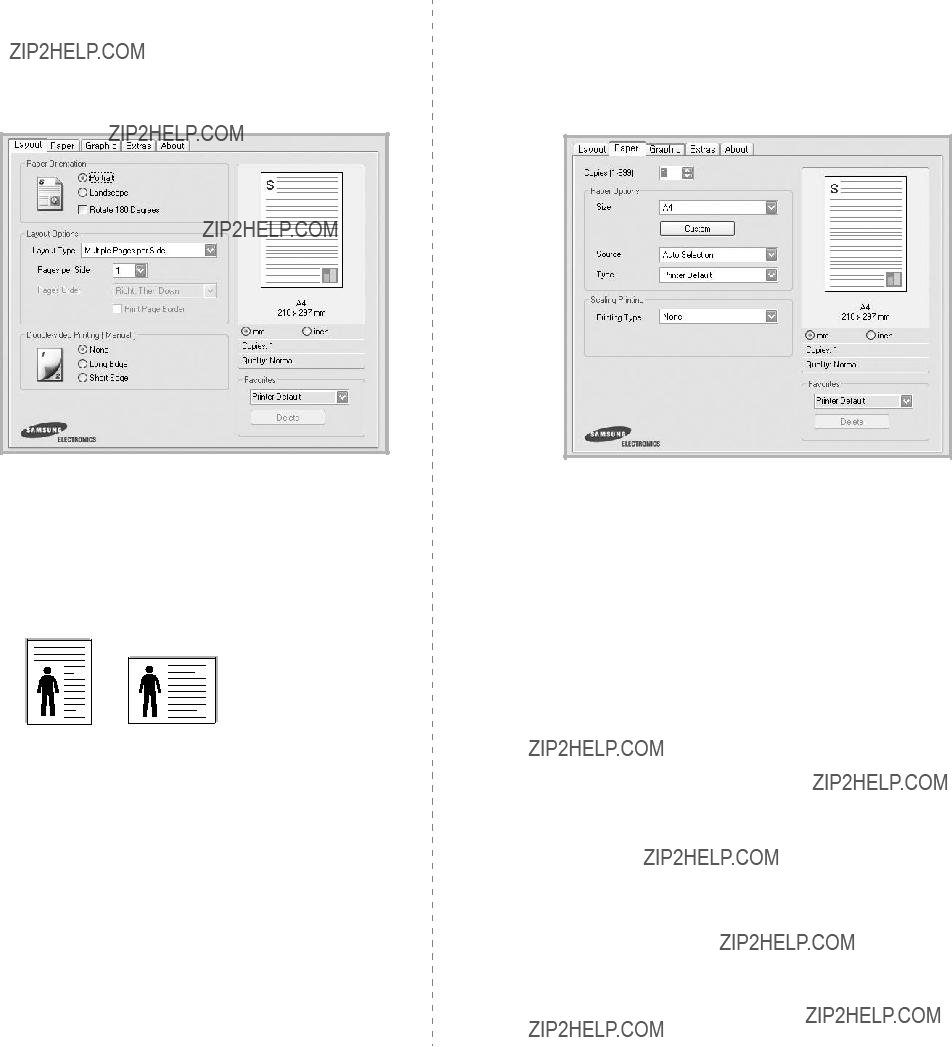
Layout Tab
The Layout tab provides options to adjust how the document appears on the printed page. The Layout Options includes
Multiple Pages per Side, Poster Printing and Booklet Printing. See ???Printing a Document??? on page 13 for more information on accessing printer properties.
Paper Orientation
Paper Orientation allows you to select the direction in which information is printed on a page.
???Portrait prints across the width of the page, letter style.
???Landscape prints across the length of the page, spreadsheet style.
???Rotate 180 Degrees allows you to rotate the page, 180
degrees.
 Portrait
Portrait  Landscape
Landscape
Layout Options
Layout Options allows you to select advanced printing options. You can choose Multiple Pages per Side and Poster Printing.
??? For details, see ???Printing Multiple Pages on One Sheet of Paper
??? For details, see ???Printing Posters??? on page 20
??? For details, see ???Printing Booklets??? on page 20
??? For details, see ???Printing on Both Sides of Paper??? on page 21.
15 Basic Printing
Paper Tab
Use the following options to set the basic paper handling specifications when you access the printer properties. See ???Printing a Document??? on page 13 for more information on accessing printer properties.
Click the Paper tab to access various paper properties.
Copies
Copies allows you to choose the number of copies to be printed. You can select 1 to 999 copies.
Paper Options
Size
Size allows you to set the size of paper you loaded in the tray. If the required size is not listed in the Size box, click Custom. When the Custom Paper Setting window appears, set the paper size and click OK. The setting appears in the list so that you can select it.

Source
Make sure that Source is set to the corresponding paper tray. Use Manual Feeder when printing on special materials like envelopes and transparencies.
Type
Set Type to correspond to the paper loaded in the tray from which you want to print. This will let you get the best quality printout. If not, print quality may not be acheived as you want.
Thick Paper: 24 lb to 28 lb (90~105 g/m2) thick paper.
Thin Paper: 16 lb to 19 lb (60~70 g/m2) thin paper.
Cotton: 20 lb to 24 lb (75~90 g/m2) cotton paper such as Gilbert 25 % and Gilbert 100 %.
Plain Paper: Normal plain paper. Select this type if your printer is monochrome and printing on the 16 lb (60 g/m2) cotton paper. Recycled Paper: 20 lb to 24 lb (75~90 g/m2) recycled paper.
Color Paper: 20 lb to 24 lb (75~90 g/m2)
Archive Paper: If you need to keep
Glossy Photo 160 g/m2 (Glossy Photo 44 lb): 44 lb (160 g/ m2) glossy paper.
Scaling Printing
Scaling Printing allows you to automatically or manually scale your print job on a page. You can choose from None, Reduce/ Enlarge, and Fit to Page.
???For details, see ???Printing a Reduced or Enlarged Document??? on page 21.
???For details, see ???Fitting Your Document to a Selected Paper
Size??? on page 21.
16 Basic Printing
Graphics Tab
Use the following Graphic options to adjust the print quality for your specific printing needs. See ???Printing a Document??? on page 13 for more information on accessing printer properties.
Click the Graphic tab to display the properties shown below.
Quality
The Quality options you can select may vary depending on your printer model. The higher the setting, the sharper the clarity of printed characters and graphics. The higher setting also may increase the time it takes to print a document.
Color Mode
You can choose color options. Setting to Color typically produces the best possible print quality for color documents. If you want to print a color document in grayscale, select Grayscale. If you want to adjust the color options manually, select Manual and click the Color Adjust or Color Matching button.
???Copies Setting: In order to use this option, first you need to set total number of copies from Paper tab. When you make several copies, and if you want to print some copies in color and some in grayscale, use this option and select the number of copies in grayscale.
???Color Adjust: You can adjust the appearance of images by changing the settings in the Levels option.
???Color Matching: You can adjust the appearance of images by changing the settings in the Settings option.

Advanced Options
You can set advanced settings by clicking the Advanced Options button.
???Print All Text To Black: When the Print All Text To Black option is checked, all text in your document prints solid black, regardless of the color it appears on the screen.
???Print All Text To Darken: When the Print All Text To Darken option is checked, all text in your document is allowed to print darker than on a normal document. Some printers do not support this feature.
???Grayscale Enhancement: Press the Smart Color tab. It allows users to preserve the details of nature photos, and improve contrast and readability among gray scaled colors, when printing color documents in grayscale.
???Fine Edge: Press the Smart Color tab. It allows users to emphasize edges of texts and fine lines for improving readability and align each color channel registration in color printing mode.
Extras Tab
You can select output options for your document. See ???Printing a Document??? on page 13 for more information about accessing the printer properties.
Click the Extras tab to access the following feature:
Watermark
You can create a background text image to be printed on each page of your document. For details, see ???Using Watermarks??? on page 22.
Overlay
Overlays are often used to take the place of preprinted forms and letterhead paper. For details, see ???Using Overlays??? on page 23.
Output Options
???Print Subset: You can set the sequence in which the pages print. Select the print order from the
-Normal (1,2,3): Your printer prints all pages from the first page to the last page.
-Reverse All Pages (3,2,1): Your printer prints all pages from the last page to the first page.
-Print Odd Pages: Your printer prints only the odd numbered pages of the document.
-Print Even Pages: Your printer prints only the even numbered pages of the document.
17 Basic Printing

About Tab
Use the About tab to display the copyright notice and the version number of the driver. If you have an Internet browser, you can connect to the Internet by clicking on the web site icon. See ???Printing a Document??? on page 13 for more information about accessing printer properties.
Printer Tab
If you access printer properties through the Printers folder, you can view the Printer tab. You can set the printer configuration.
The following procedure is for Windows XP. For other Windows OS, refer to the corresponding Windows User's Guide or online help.
1Click the Windows Start menu.
2Select Printers and Faxes.
3Select your printer driver icon.
4
Properties.
5 Click the Printer tab and set the options.
18 Basic Printing
Using a Favorite Setting
The Favorites option, which is visible on each properties tab, allows you to save the current properties settings for future use.
To save a Favorites item:
1Change the settings as needed on each tab.
2Enter a name for the item in the Favorites input box.
3Click Save.
When you save Favorites, all current driver settings are saved.
To use a saved setting, select the item from the Favorites drop down list. The printer is now set to print according to the Favorites setting you selected.
To delete a Favorites item, select it from the list and click
Delete.
You can also restore the printer driver???s default settings by selecting Printer Default from the list.
Using Help
Your printer has a help screen that can be activated by clicking the Help button in the printer properties window. These help screens give detailed information about the printer features provided by the printer driver.
You can also click  from the upper right corner of the window, and then click on any setting.
from the upper right corner of the window, and then click on any setting.
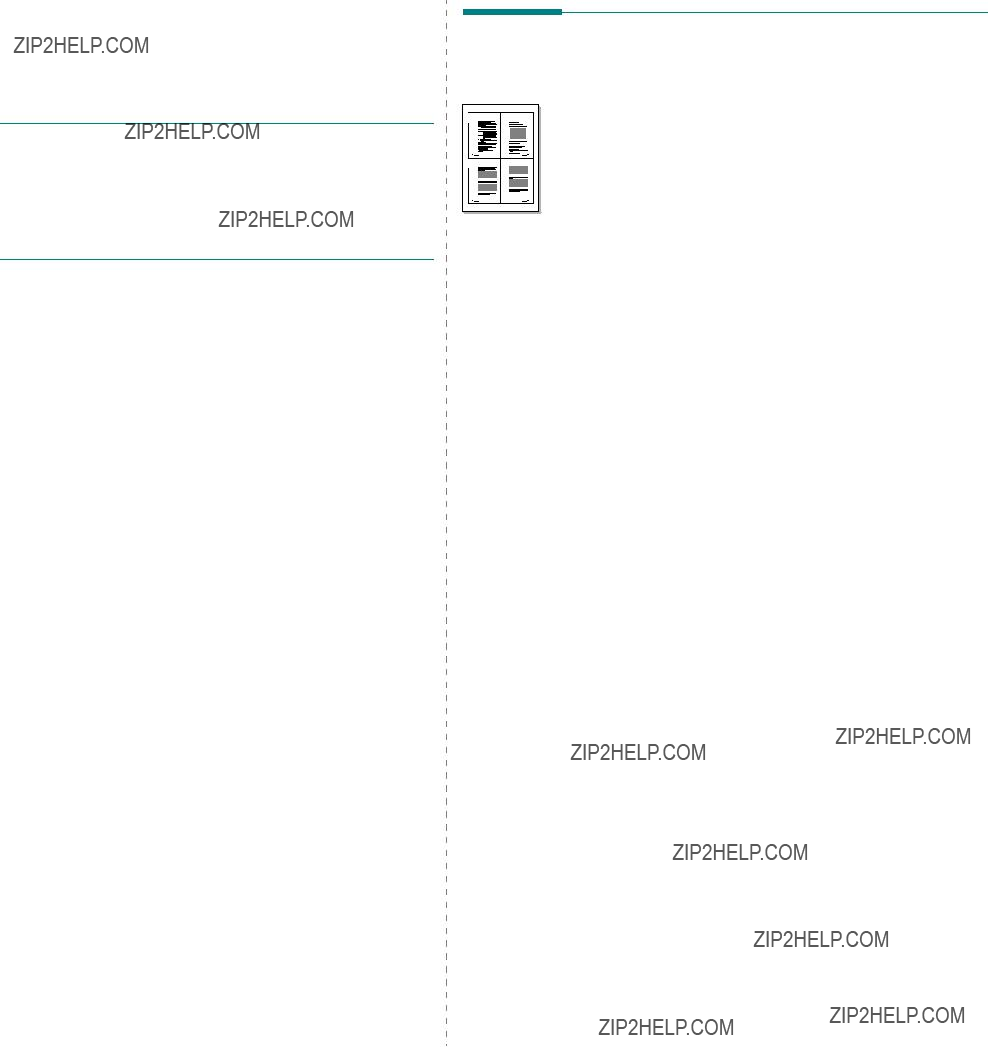
3 Advanced Printing
This chapter explains printing options and advanced printing tasks.
NOTE:
???Your printer driver Properties window that appears in this User???s Guide may differ depending on the printer in use. However the composition of the printer properties window is similar.
???If you need to know the exact name of your printer, you can check the supplied
This chapter includes:
???Printing Multiple Pages on One Sheet of Paper
???Printing Posters
???Printing Booklets
???Printing on Both Sides of Paper
???Printing a Reduced or Enlarged Document
???Fitting Your Document to a Selected Paper Size
???Using Watermarks
???Using Overlays
1  2
2 
3  4
4 
Printing Multiple Pages on One Sheet of Paper
You can select the number of pages to print on a single sheet of paper. To print more than one page per sheet, the pages will be reduced in size and arranged in the order you specify. You can print up to 16 pages on one sheet.
1To change the print settings from your software application, access printer properties. See ???Printing a Document??? on page 13.
2From the Layout tab, choose Multiple Pages per Side in the Layout Type
3Select the number of pages you want to print per sheet (1, 2, 4, 6, 9, or 16) in the Pages per Side
4Select the page order from the Page Order
Check Print Page Border to print a border around each page on the sheet.
5Click the Paper tab, select the paper source, size, and type.
6Click OK and print the document.
19 Advanced Printing
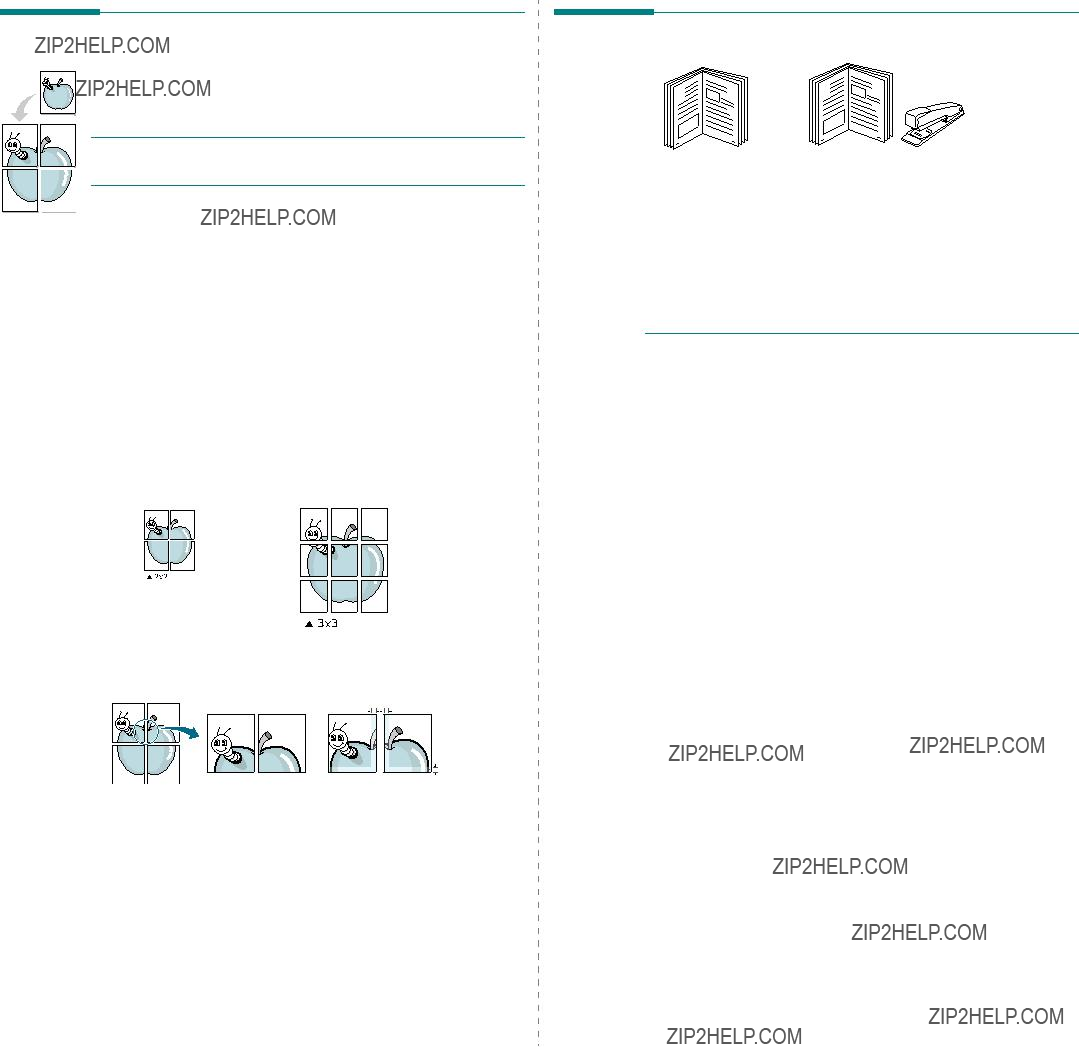
Printing Posters
This feature allows you to print a
NOTE: The poster printing option is available when 600 dpi is selected in the resolution option on the Graphic tab.
1To change the print settings from your software
application, access printer properties. See ???Printing a Document??? on page 13.
2Click the Layout tab, select Poster Printing in the Layout Type
3Configure the poster option:
You can select the page layout from Poster<2x2>,
Poster<3x3>, Poster<4x4> or Custom. If you select
Poster<2x2>, the output will be automatically stretched to cover 4 physical pages. If the option is set to Custom,
you can enlarge the original from 150% to 400%. Depending on the level of the enlargement, the page layout is automatically adjusted to Poster<2x2>,
Poster<3x3>, Poster<4x4>.
Specify an overlap in millimeters or inches to make it easier to pasting the sheets together.
0.15 inches
0.15 inches
4Click the Paper tab, select the paper source, size, and type.
5Click OK and print the document. You can complete the poster by pasting the sheets together.
20 Advanced Printing
Printing Booklets
This printer feature allows you to print your document on both sides of the paper and arranges the pages so that the paper can be folded in half after printing to produce a booklet.
1To change the print settings from your software application, access the printer properties. See ???Printing a Document??? on page 13.
2From the Layout tab, choose Booklet Printing from the Layout Type
NOTE: The Booklet Printing option is not available for all paper sizes. In order to find out the available paper size for this feature, select the paper size in the Size option on the
Paper tab, then check if the Booklet Printing in a Layout Type
3Click the Paper tab, and select the paper source, size, and type.
4Click OK and print the document.
5After printing, fold and staple the pages.

Printing on Both Sides of Paper
You can print on both sides of a sheet of paper. Before printing, decide how you want your document oriented.
The options are:
???None
???Long Edge, which is the conventional layout used in book binding.
???Short Edge, which is the type often used with calendars.
Printing a Reduced or Enlarged Document
You can change the size of a page???s content to appear larger or smaller on the printed page.
??? Long Edge
2
??? Short Edge
NOTE:
??? Do not print on both sides of labels, transparencies, envelopes, or thick paper. Paper jamming and damage to the printer may result.
4Click the Paper tab and select the paper source, size, and type.
5Click OK and print the document.
NOTE: If your printer does not have a duplex unit, you should complete the printing job manually. The printer prints every other page of the document first. After printing the first side of your job, the Printing Tip window appears. Follow the on- screen instructions to complete the printing job.
21 Advanced Printing
Fitting Your Document to a Selected Paper Size
This printer feature allows you to scale your print job to any selected paper size regardless of the digital document size. This can be useful when you want to check fine details on a small document.
1To change the print settings from your software application, access printer properties. See ???Printing a Document??? on page 13.
2From the Paper tab, select Fit to Page in the Printing Type
3Select the correct size from the Output size
4Select the paper source, size, and type in Paper Options.
5Click OK and print the document.
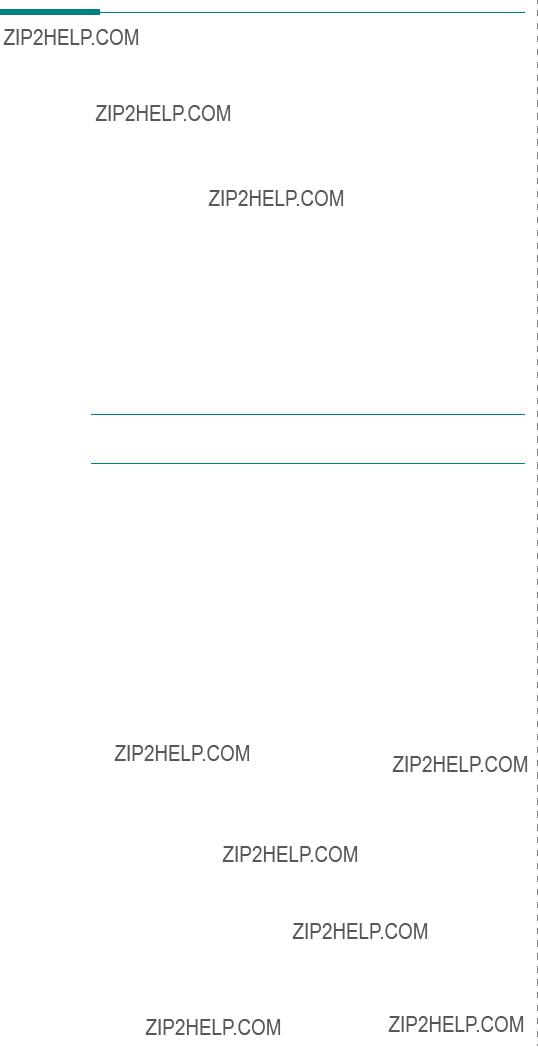
Using Watermarks
The Watermark option allows you to print text over an existing document. For example, you may want to have large gray letters reading ???DRAFT??? or ???CONFIDENTIAL??? printed diagonally across the first page or all pages of a document.
There are several predefined watermarks that come with the printer, and they can be modified, or you can add new ones to the list.
Using an Existing Watermark
1 To change the print settings from your software application, access printer properties. See ???Printing a Document??? on page 13.
2Click the Extras tab, and select the desired watermark from the Watermark
3Click OK and start printing.
NOTE: The preview image shows how the page will look when it is printed.
Creating a Watermark
1To change the print settings from your software application, access printer properties. See ???Printing a Document??? on page 13.
2Click the Extras tab, and click the Edit button in the
Watermark section. The Edit Watermark window appears.
3Enter a text message in the Watermark Message box. You can enter up to 40 characters. The message displays in the preview window.
When the First Page Only box is checked, the watermark prints on the first page only.
4Select watermark options.
You can select the font name, style, size, or grayscale level from the Font Attributes section and set the angle of the watermark from the Message Angle section.
5 Click Add to add a new watermark to the list.
6When you have finished editing, click OK and start printing.
To stop printing the watermark, select (No Watermark) from the Watermark
22 Advanced Printing
Editing a Watermark
1To change the print settings from your software
application, access printer properties. See ???Printing a Document??? on page 13.
2Click the Extras tab and click the Edit button in the
Watermark section. The Edit Watermark window appears.
3Select the watermark you want to edit from the Current
Watermarks list and change the watermark message and options.
4Click Update to save the changes.
5Click OK until you exit the Print window.
Deleting a Watermark
1To change the print settings from your software application, access printer properties. See ???Printing a Document??? on page 13.
2From the Extras tab, click the Edit button in the Watermark section. The Edit Watermark window appears.
3Select the watermark you want to delete from the Current Watermarks list and click Delete.
4Click OK until you exit the Print window.

Dear ABC
Regards
 WORLD BEST
WORLD BEST 
Using Overlays
What is an Overlay?
An overlay is text and/or images stored in the computer hard disk drive (HDD) as a special file format that can be printed on any document. Overlays are often used to take the place of preprinted forms and letterhead paper. Rather than using preprinted letterhead, you can create an overlay containing the exact same information that is currently on your letterhead. To print a letter with your company???s letterhead, you do not need to load preprinted letterhead paper in the printer. You need only tell the printer to print the letterhead overlay on your document.
Using a Page Overlay
After an overlay has been created, it is ready to be printed with your document. To print an overlay with a document:
Creating a New Page Overlay
To use a page overlay, you must create a new page overlay containing your logo or image.
1Create or open a document containing text or an image for
use in a new page overlay. Position the items exactly as you wish them to appear when printed as an overlay.
2To save the document as an overlay, access printer properties. See ???Printing a Document??? on page 13.
3Click the Extras tab, and click Edit button in the Overlay section.
4In the Edit Overlay window, click Create Overlay.
5In the Create Overlay window, type a name of up to eight characters in the File name box. Select the destination path, if necessary. (The default is C:\Formover).
6Click Save. The name appears on the Overlay List box.
7Click OK or Yes to finish creating.
The file is not printed. Instead it is stored on your computer hard disk drive.
NOTE: The overlay document size must be the same as the documents you print with the overlay. Do not create an overlay with a watermark.
NOTE: The resolution of the overlay document must be the same as that of the document you will print with the overlay.
Deleting a Page Overlay
You can delete page overlays that you no longer use.
1In the printer properties window, click the Extras tab.
2Click the Edit button in the Overlay section.
3Select the overlay you want to delete from the Overlay List box.
4Click Delete Overlay.
5When a confirming message window appears, click Yes.
6Click OK until you exit the Print window.
23 Advanced Printing
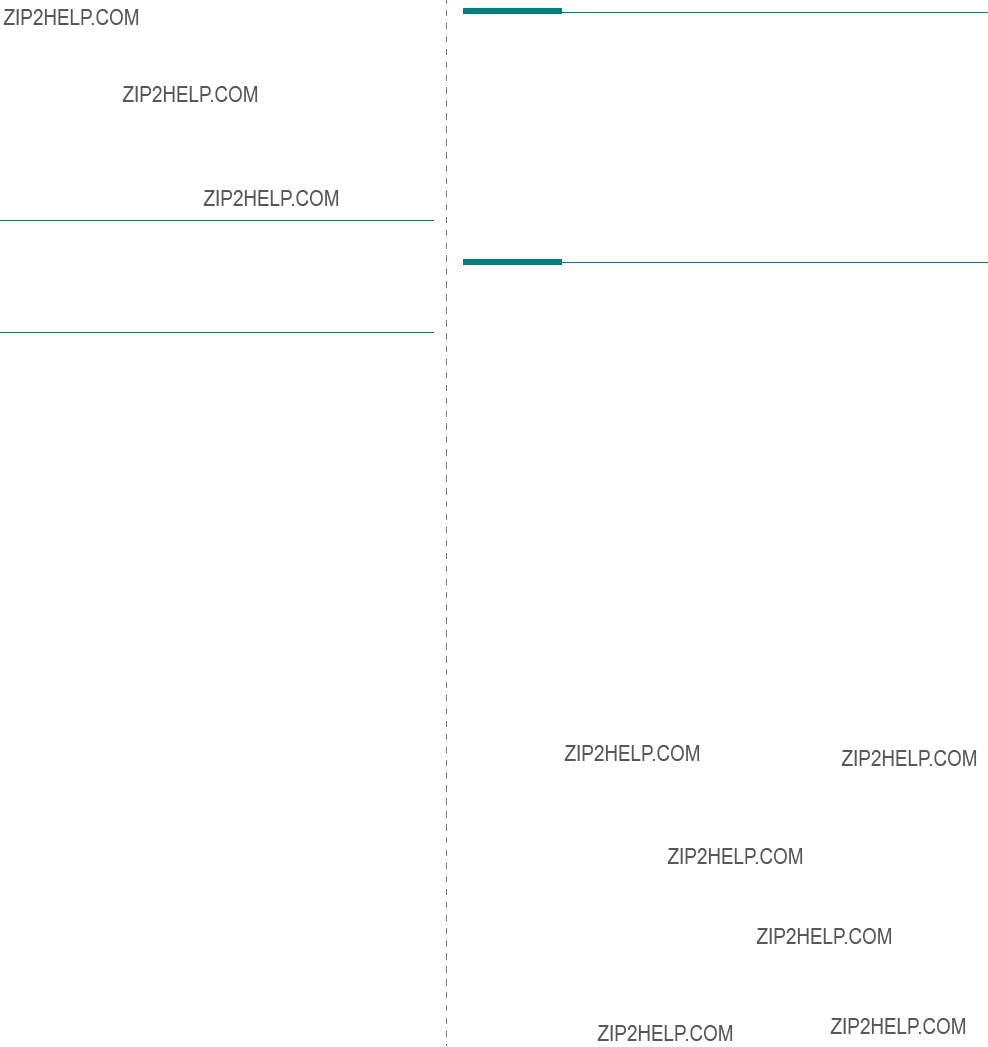
4 Sharing the Printer
Locally
You can connect the printer directly to a selected computer, which is called ???host computer,??? on the network.
The following procedure is for Windows XP. For other Windows OS, refer to the corresponding Windows User's Guide or online help.
NOTES:
???Check the Operating System(s) that are compatible with your printer. Please refer to the OS Compatibility section of Printer Specifications in your Printer User???s Guide.
???If you need to know the exact name of your printer, you can check the supplied
Setting Up a Host Computer
1Start Windows.
2From the Start menu select Printers and Faxes.
3
4From the Printer menu, select Sharing.
5Check the Share this printer box.
6Fill in the Shared Name field, and then click OK.
Setting Up a Client Computer
1
2Select My Network Places and then
3Fill in the IP address of host computer in Computer name field, and click Search. (In case host computer requires User name and Password, fill in User ID and password of host computer account.)
4
5
6Click Yes, if the installation confirm message appears.
24
Sharing the Printer Locally

5 Using Smart Panel
Smart Panel is a program that monitors and informs you of the status of the printer, and allows you to customize the printer???s settings. Smart Panel is installed automatically when you install the printer software.
NOTES:
???To use this program, you need:
-To check for Operating System(s) that are compatible with your printer, refer to Printer Specifications in your Printer User???s Guide.
-Mac OS X 10.3 or higher
-Linux. To check for Linux systems that are compatible with your printer, refer to Printer Specifications in your Printer User???s Guide.
-Internet Explorer version 5.0 or higher for flash animation in HTML Help.
???If you need to know the exact name of your printer, you can check the supplied
Understanding Smart Panel
If an error occurs while printing, Smart Panel appears automatically, showing the error.
You can also launch Smart Panel manually.
Click this icon in Mac OS X.
Click this icon in Linux.
If you are a Windows user, from the Start menu, select
Programs or All Programs ???your printer driver name ??? Smart Panel.
NOTES:
???If you have already installed more than one Samsung printer, first select the printer model you want in order to use the corresponding Smart Panel.
???The Smart Panel window and its contents shown in this Software User???s Guide may differ depending on the printer or Operating System in use.
The Smart Panel program displays the current status of the printer, the level of toner remaining in the toner cartridge(s) and various other information. You can also change settings.
1
1 Toner Level
You can view the level of toner remaining in the toner cartridge(s). The printer and the number of toner cartridge(s) shown in the above window may differ depending on the printer in use. Any printers do not have this feature.
Buy Now
You can order replacement toner cartridge(s) online.
Troubleshooting Guide
You can view Help to solve problems.
Printer Setting
You can configure various printer settings in the Printer Settings Utility window. Any printers do not have this feature.
NOTE: If your printer is connected to a network and you are a Windows and Mac OS X user, the SyncThru Web Service window appears instead of the Printer Settings Utility window. Linux does not support network environments.
25
Using Smart Panel

Driver Setting (Only for Windows)
You can use the printer properties window, which allows you to access all of the printer options you need for using your printer. For details, See ???Printer Settings??? on page 14.
Opening the Troubleshooting
Guide
Using the troubleshooting guide, you can view solutions for error status problems.
Changing the Smart Panel
Program Settings
Using Printer Settings Utility
Using the Printer Settings Utility, you can configure and check print settings.
1
2
3
Change the settings.
To send the changes to the printer, click the Apply button.
NOTES: If your printer is connected to a network, the SyncThru Web Service window appears instead of the Printer Settings Utility window.
Using Onscreen Help File
For more information about Printer Settings Utility, click  .
.
26
Using Smart Panel
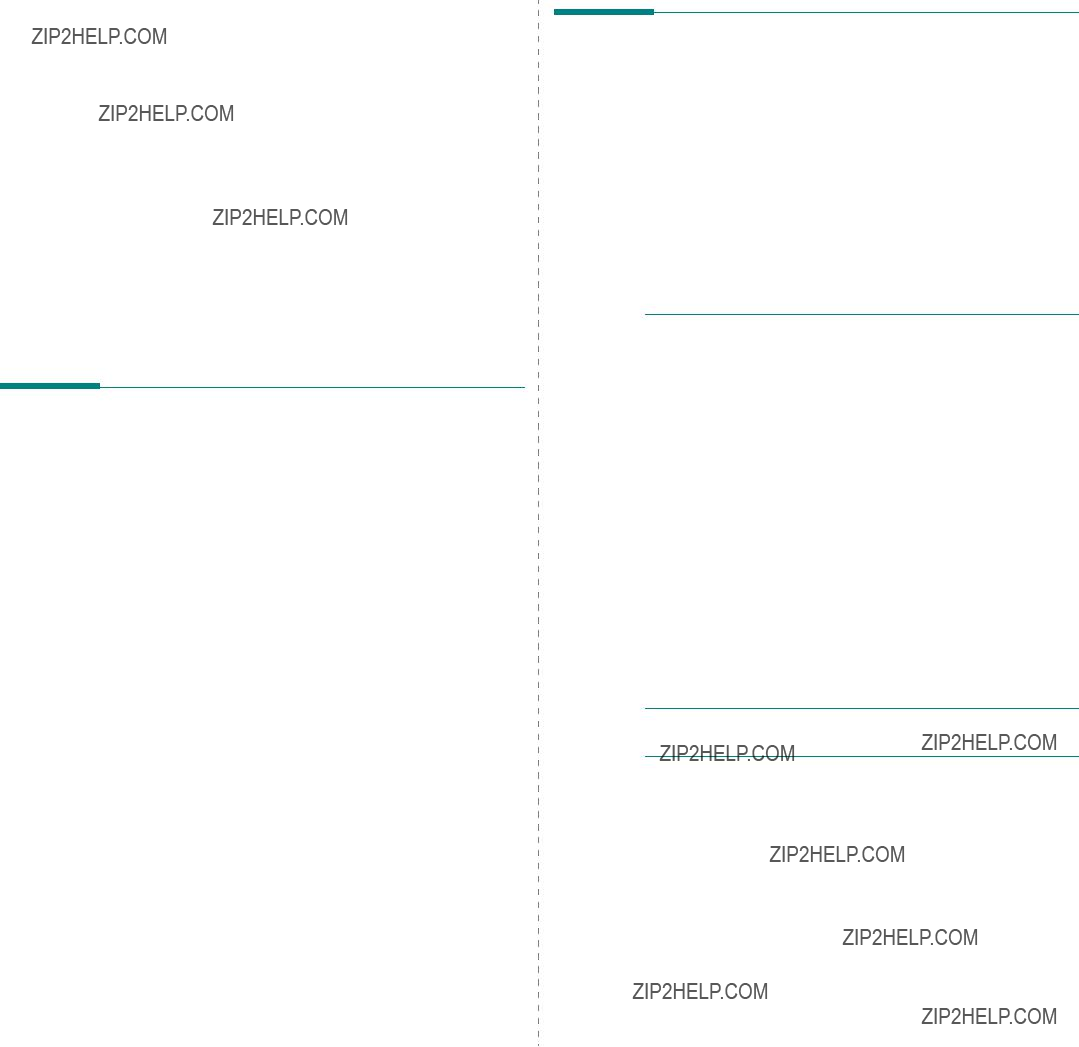
6 Using Your Printer in
Linux
You can use your machine in a Linux environment.
This chapter includes:
???Getting Started
???Installing the Unified Linux Driver
???Using SetIP program
???Using the Unified Driver Configurator
???Configuring Printer Properties
???Printing a Document
Getting Started
The supplied
After the driver is installed on your Linux system, the driver package allows you to monitor a number of machine devices via fast ECP parallel ports and USB simultaneously.
The Unified Linux Driver package is supplied with a smart and flexible installation program. You don't need to search for additional components that might be necessary for the Unified Linux Driver software: all required packages will be carried onto your system and installed automatically; this is possible on a wide set of the most popular Linux clones.
Installing the Unified Linux
Driver
Installing the Unified Linux Driver
1Make sure that you connect your machine to your computer. Turn both the computer and the machine on.
2When the Administrator Login window appears, type in root in the Login field and enter the system password.
NOTE: You must log in as a super user (root) to install the printer software. If you are not a super user, ask your system administrator.
3Insert the printer software
If the  icon at the bottom of the desktop. When the Terminal screen appears, type in:
icon at the bottom of the desktop. When the Terminal screen appears, type in:
If the
[root@localhost root]#mount
[root@localhost root]#cd /mnt/cdrom/Linux [root@localhost root]#./install.sh
If you still failed to run the
[root@localhost root]#umount /dev/hdc
[root@localhost root]#mount
NOTE: The installation program runs automatically if you have an autorun software package installed and configured.
27
Using Your Printer in Linux

4
5
When the welcome screen appears, click Next.
When the installation is complete, click Finish.
Uninstalling the Unified Linux Driver
1When the Administrator Login window appears, type in root in the Login field and enter the system password.
NOTE: You must log in as a super user (root) to uninstall the printer software. If you are not a super user, ask your system administrator.
2Insert the printer software
If the  icon at the bottom of the desktop. When the Terminal screen appears, type in:
icon at the bottom of the desktop. When the Terminal screen appears, type in:
If the
[root@localhost root]#mount
[root@localhost root]#cd /mnt/cdrom/Linux [root@localhost root]#./uninstall.sh
NOTE: The installation program runs automatically if you have an autorun software package installed and configured.
3Click Uninstall.
4Click Next.
???Follow the step 1 to 3, then type [root@localhost Linux]# ./ install.sh, then follow the instruction on the terminal screen. Then the installation completes.
???When you wan to uninstall the driver, follow the installation instruction above, but type [root@localhost Linux]# ./ uninstall.sh on the terminal screen.
28
Using Your Printer in Linux

Using SetIP program
This program is for the network IP setting using the MAC address which is the hardware serial number of the network printer card or interface. Especially, it is for the network administrator to set several network IPs at the same time.
You can only use SetIP program when your machine is connected to a network.
SetIP program should be automatically installed during the printer driver installation.
Starting the program
1Print the machine???s network information report which includes your machine???s MAC address.
2Open the /opt/Samsung/mfp/share/utils/.
3Double click the SetIPApplet.html file.
4Click  in the SetIP window to open the TCP/IP configuration window.
in the SetIP window to open the TCP/IP configuration window.
5Enter the network card's MAC address, IP address, subnet mask, default gateway, and then click Apply.
NOTE: when you enter the MAC address, enter it without colon(:).
6The machine prints the network information. Confirm all the settings are correct.
7Close the SetIP program.
Using the Unified Driver
Configurator
Unified Linux Driver Configurator is a tool primarily intended for configuring Printer.
After installing the Unified Linux driver, the Unified Linux Driver Configurator icon will automatically be created on your desktop.
Opening the Unified Driver
Configurator
1
You can also click the Startup Menu icon and select
Samsung Unified Driver and then Unified Driver Configurator.
2Press each button on the Modules pane to switch to the corresponding configuration window.
Printers Configuration button
Ports Configuration button
You can use the onscreen help by clicking Help.
3After changing the configurations, click Exit to close the Unified Driver Configurator.
29
Using Your Printer in Linux

Printers Configuration
Printers configuration has the two tabs: Printers and Classes.
Printers Tab
You can see the current system???s printer configuration by clicking on the printer icon button on the left side of the Unified Driver Configurator window.
Switches to Printer configuration.
Shows all of the installed printer.
Shows the status, model name and URI of your printer.
You can use the following printer control buttons:
???Refresh: renews the available printers list.
???Add Printer: allows you to add a new printer.
???Remove Printer: removes the selected printer.
???Set as Default: sets the current printer as a default printer.
???Stop/Start: stops/starts the printer.
???Test: allows you to print a test page to check if the machine is working properly.
???Properties: allows you to view and change the printer properties. For details, see page 31.
Classes Tab
The Classes tab shows a list of available printer classes.
Shows all of the printer classes.
Shows the status of the class and the number of  printers in the class.
printers in the class.
???Refresh : Renews the classes list.
???Add Class... : Allows you to add a new printer class.
???Remove Class : Removes the selected printer class.
Ports Configuration
In this window, you can view the list of available ports, check the status of each port and release a port that is stalled in busy state when its owner is terminated for any reason.
???Refresh : Renews the available ports list.
???Release port : Releases the selected port.
30
Using Your Printer in Linux
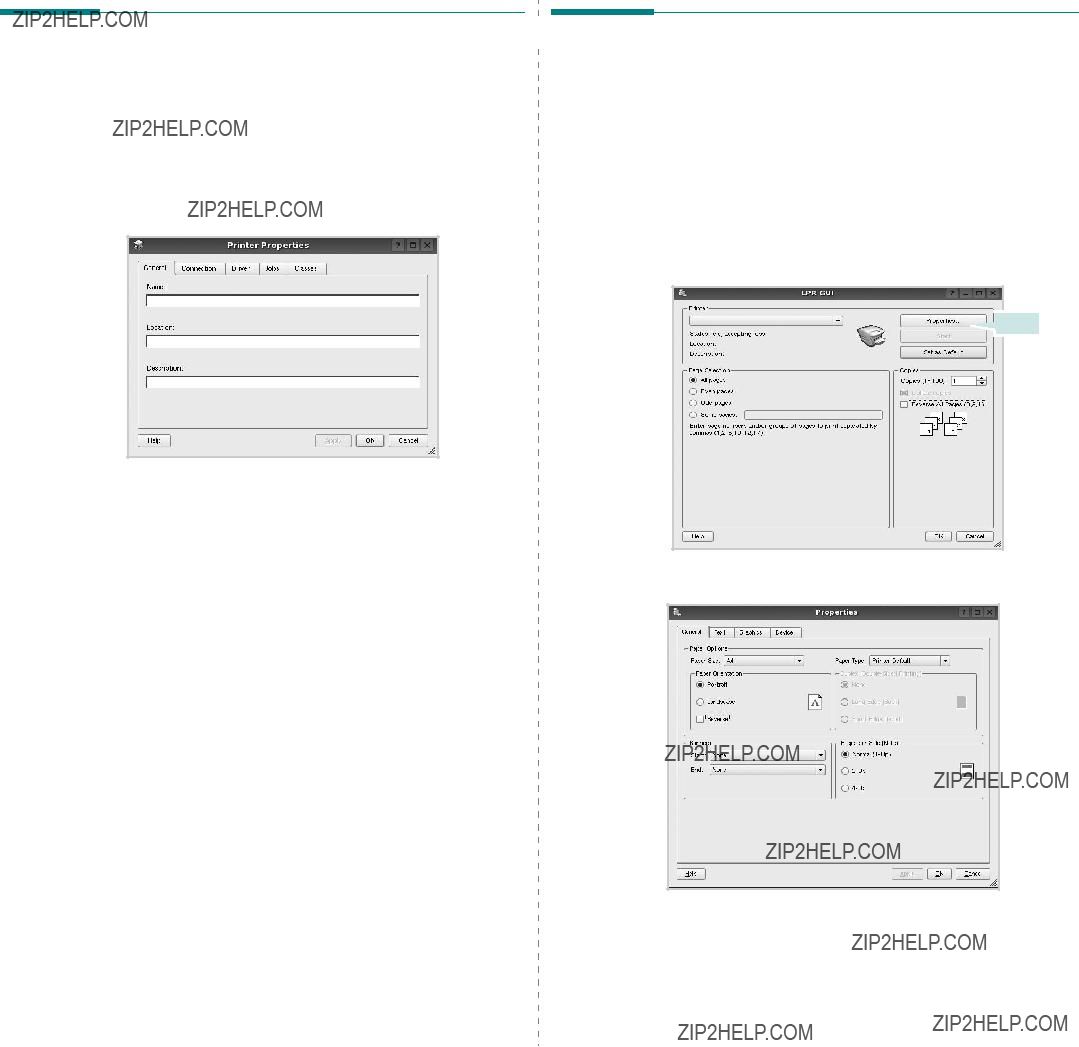
Using the properties window provided by the Printers configuration, you can change the various properties for your machine as a printer.
1 Open the Unified Driver Configurator.
If necessary, switch to Printers configuration.
2Select your machine on the available printers list and click
Properties.
3The Printer Properties window opens.
The following five tabs display at the top of the window:
???General: allows you to change the printer location and name. The name entered in this tab displays on the printer list in Printers configuration.
???Connection: allows you to view or select another port. If you change the printer port from USB to parallel or vice versa while in use, you must
???Driver: allows you to view or select another printer driver. By clicking Options, you can set the default device options.
???Jobs: shows the list of print jobs. Click Cancel job to cancel the selected job and select the Show completed jobs check box to see previous jobs on the job list.
???Classes: shows the class that your printer is in. Click Add to Class to add your printer to a specific class or click Remove from Class to remove the printer from the selected class.
4Click OK to apply the changes and close the Printer Properties Window.
31
Using Your Printer in Linux
Printing from Applications
There are a lot of Linux applications that you are allowed to print from using Common UNIX Printing System (CUPS). You can print on your machine from any such application.
1From the application you are using, select Print from the File menu.
2Select Print directly using lpr.
3In the LPR GUI window, select the model name of your machine from the Printer list and click Properties.
 Click.
Click.
4 Change the printer and print job properties.

The following four tabs display at the top of the window.
???General - allows you to change the paper size, the paper type, and the orientation of the documents, enables the duplex feature, adds start and end banners, and changes the number of pages per sheet.
???Text - allows you to specify the page margins and set the text options, such as spacing or columns.
???Graphics - allows you to set image options that are used when printing images/files, such as color options, image size, or image position.
???Device: allows you to set the print resolution, paper source, and destination.
5Click Apply to apply the changes and close the Properties window.
6Click OK in the LPR GUI window to start printing.
7The Printing window appears, allowing you to monitor the status of your print job.
To abort the current job, click Cancel.
Printing Files
You can print many different types of files on the Samsung machine device using the standard CUPS way - directly from the command line interface. The CUPS lpr utility allows you do that. But the drivers package replaces the standard lpr tool by a much more
To print any document file:
1 Type lpr <file_name> from the Linux shell command line and press Enter. The LPR GUI window appears.
When you type only lpr and press Enter, the Select file(s) to print window appears first. Just select any files you want to print and click Open.
2 In the LPR GUI window, select your printer from the list, and change the printer and print job properties.
For details about the properties window, see page 31. 3 Click OK to start printing.
32
Using Your Printer in Linux

7 Using Your Printer with a Macintosh
Your printer supports Macintosh systems with a
NOTE: Some printers do not support a network interface. Make sure that your printer supports a network interface by referring to Printer Specifications in your Printer User???s Guide.
This chapter includes:
???Installing Software
???Using SetIP program
???Setting Up the Printer
???Printing
Installing Software
The
Printer driver
Installing the Printer driver
1Make sure that you connect your printer to the computer. Turn on your computer and printer.
2Insert the
3
4
5
6
7Enter the password and click OK.
8The Samsung SPL Installer window opens. Click Continue and then click Continue.
9Select Easy Install and click Install.
10After the installation is finished, click Quit.
Uninstalling the Printer driver
Uninstall is required if you are upgrading the software, or if installation fails.
1Insert the
2
3
4
5
6Enter the password and click OK.
7The Samsung SPL Installer window opens. Click Continue and then click Continue.
8Select Uninstall and then click Uninstall.
9When the uninstallation is done, click Quit.
33
Using Your Printer with a Macintosh

Using SetIP program
This program is for the network IP setting using the MAC address which is the hardware serial number of the network printer card or interface. Especially, it is for the network administrator to set several network IPs at the same time.
You can only use SetIP program when your machine is connected to a network.
Setting Up the Printer
Set up for your printer will be different depending on which cable you use to connect the printer to your
For a
SetIP program should be automatically installed during the printer driver installation.
NOTE: If you select Typical installation for a network printer during the printer driver installation, the SetIP program automatically runs after the installation. Follow the below instruction.
1The certificate window appears, click Trust.
2Print the machine???s network information report which includes your machine???s MAC address.
3 Click  in the SetIP window to open the TCP/IP configuration window.
in the SetIP window to open the TCP/IP configuration window.
4Enter the network card's MAC address, IP address, subnet mask, default gateway, and then click Apply.
NOTE: when you enter the MAC address, enter it without colon(:).
5The machine prints the network information. Confirm all the settings are correct.
6 Close the SetIP program.
Starting the program
If you want to change your network printer IP setting, follow the below instruction.
1 Print the machine???s network information report which includes your machine???s MAC address.
2Open the Library folder ???Printers ???Samsung ??? Your printer model name ???SetIP.
3Double click the SetIPApplet.html file.
4The certificate window appears, click Trust.
5Click  in the SetIP window to open the TCP/IP configuration window.
in the SetIP window to open the TCP/IP configuration window.
6Enter the network card's MAC address, IP address, subnet mask, default gateway, and then click Apply.
when you enter the MAC address, enter it without colon(:).
7The machine prints the network information. Confirm all the settings are correct.
8Close the SetIP program.
34
NOTE: Some printers do not support a network interface. Before connecting your printer, make sure that your printer supports a network interface by referring to Printer Specifications in your Printer User???s Guide.
1Follow the instructions on ???Installing Software??? on page 33 to install the PPD and Filter files on your computer.
2Open the Applications folder ???Utilities, and Print Setup Utility.
???For MAC OS 10.5, open System Preferences from the
Applications folder, and click Printer & Fax.
3Click Add on the Printer List.
???For MAC OS 10.5, press the ???+??? icon then a display window will pop up.
4For MAC OS 10.3, select the IP Printing tab. ???For MAC OS 10.4, click IP Printer.
???For MAC OS 10.5, click IP.
5Select Socket/HP Jet Direct in Printer Type.
WHEN PRINTING A DOCUMENT CONTAINING MANY
PAGES, PRINTING PERFORMANCE MAY BE
ENHANCED BY CHOOSING SOCKET FOR PRINTER
TYPE OPTION.
6Enter the printer???s IP address in the Printer Address field.
7Enter the queue name in the Queue Name field. If you cannot determine the queue name for your printer server, try using the default queue first.
8For MAC OS 10.3, if Auto Select does not work properly, select Samsung in Printer Model and your printer name in Model Name.
???For MAC OS 10.4, if Auto Select does not work properly, select Samsung in Print Using and your printer name in Model.
???For MAC OS 10.5, if Auto Select does not work properly, select Select a driver to use... and your printer name in Print Using.
Your printer???s IP address appears on the Printer List, and is set as the default printer.
9Click Add.
Using Your Printer with a Macintosh

For a
1
2
3
Follow the instructions on ???Installing Software??? on page 33 to install the PPD and Filter files on your computer.
Open the Applications folder ???Utilities, and Print Setup Utility.
???For MAC OS 10.5, open System Preferences from the
Applications folder, and click Printer & Fax. Click Add on the Printer List.
4
5
6
???For MAC OS 10.5, press the ???+??? icon then a display window will pop up.
For MAC OS 10.3, select the USB tab.
???For MAC OS 10.4, click Default Browser and find the USB connection.
???For MAC OS 10.5, click Default and find the USB connection.
For MAC OS 10.3, if Auto Select does not work properly,
select Samsung in Printer Model and your printer name in Model Name.
???For MAC OS 10.4, if Auto Select does not work properly, select Samsung in Print Using and your printer name in Model.
???For MAC OS 10.5, if Auto Select does not work properly, select Select a driver to use... and your printer name in Print Using.
Your machine appears on the Printer List and is set as the default printer.
Click Add.
35
Using Your Printer with a Macintosh

Printing
NOTES:
???The Macintosh printer???s properties window that appears in this User???s Guide may differ depending on the printer in use. However the composition of the printer properties window is similar.
???You can check your printer name in the supplied CD- ROM.
Printing a Document
When you print with a Macintosh, you need to check the printer software setting in each application you use. Follow these steps to print from a Macintosh.
1Open a Macintosh application and select the file you want to print.
2Open the File menu and click Page Setup (Document Setup in some applications).
3Choose your paper size, orientation, scaling, and other options and click OK.
Make sure that your printer is selected.
??? Mac OS 10.3
4Open the File menu and click Print.
5Choose the number of copies you want and indicate which pages you want to print.
6Click Print when you finish setting the options.
Changing Printer Settings
You can use advanced printing features when using your printer.
From your Macintosh application, select Print from the File menu. The printer name which appears in the printer properties window may differ depending on the printer in use. Except for the name, the composition of the printer properties window is similar.
NOTES: The setting options may differ depending on printers and Macintosh OS version.
Layout
The Layout tab provides options to adjust how the document appears on the printed page. You can print multiple pages on one sheet of paper. Select Layout from the Presets
??? Mac OS 10.4
???Pages per Sheet: This feature determines how many pages printed on one page. For details, see "Printing Multiple Pages on One Sheet of Paper" on the next column.
???Layout Direction: You can select the printing direction on a page as like the examples on UI.
36
Using Your Printer with a Macintosh

Graphics
The Graphics tab provides options for selecting
Resolution(Quality) and Color Mode. Select Graphics form the Presets'
???Mac OS 10.4
???Resolution(Quality): You can select the printing resolution. The higher the setting, the sharper the clarity of printed characters and graphics. The higher setting also may increase the time it takes to print a document.
???Color Mode: You can set the color options. Setting to Color typically produces the best possible print quality for color documents. If you want to print a color document in grayscale, select Grayscale.
Paper
Set Paper Type to correspond to the paper loaded in the tray from which you want to print. This will let you get the best quality printout. If you load a different type of print material, select the corresponding paper type.
??? Mac OS 10.4
Printer Features
This tab provides options for selecting the paper type and adjusting print quality. Select Printer Features from the Presets'
??? Mac OS 10.4
???Fit to Page: This setting allows you to scale your print job to any selected paper size regardless of the digital document size. This can be useful when you want to check fine details on a small document.
???RGB Color: This setting determines how colors are rendered. Standard is the most widely used setting which the color tone of this mode is the closest to that of standard monitor (sRGB Monitor). Vivid mode is appropriate for printing presentation data and charts. The color tone of Vivid mode produces more Vivid color images than that of Standard mode. Device mode is best used for printing fine lines, small characters and color drawings. The color tone of Device mode may be different from that of monitor, the pure toner colors are used for printing Cyan, Magenta and Yellow colors.
37
Using Your Printer with a Macintosh

Printing Multiple Pages on One Sheet of Paper
You can print more than one page on a single sheet of paper. This feature provides a
1
2
From your Macintosh application, select Print from the File menu.
Select Layout.
??? Mac OS 10.3
3
4
5
Select the number of pages you want to print on one sheet of paper on the Pages per Sheet
Select the page order from the Layout Direction option.
To print a border around each page on the sheet, select the option you want from the Border
Click Print, and the printer prints the selected number of pages on one side of each page.
38
Using Your Printer with a Macintosh
SOFTWARE SECTION
INDEX
A
advanced printing, use 19
B
booklet printing 20
D
document, print Macintosh 36 Windows 13
E
Extras properties, set 17
F
favorites settings, use 18
G
Graphics properties, set 16
H
help, use 18
I
install
printer driver
Macintosh 33
Windows 4 installing
Linux software 27
L
language, change 10 Layout properties, set
Windows 15 Linux
driver, install 27 printer properties 31 printing 31
M
Macintosh driver
install 33 uninstall 33
printing 36
setting up the printer 34 MFP driver, install
Linux 27
N
O
orientation, print 32 Windows 15
overlay create 23 delete 23 print 23
P
Paper properties, set 15 paper size, set 15
print 32
paper source, set 32 Windows 16
paper type, set print 32 poster, print 20
document 13
39
fit to page 21 from Macintosh 36 from Windows 13
Macintosh 38
Windows 19 overlay 23
poster 22 PRN 14 scaling 21 watermark 22
print resolution 32 printer driver, install
Linux 27 printer properties
Linux 31
printer properties, set Macintosh 36 Windows 14
printer resolution, set Windows 16
printer software install
Macintosh 33
Windows 4 uninstall
Macintosh 33
Windows 11 printing
booklets 20
R
resolution printing 32
S
setting darkness 16 favorites 18
image mode 16 resolution
Windows 16 toner save 16
install
Macintosh 33
Windows 4 reinstall
Windows 10 system requirements
Macintosh 33 uninstall
Macintosh 33
Windows 11 status monitor, use 25
T
toner save, set 16
U
uninstall, software Macintosh 33 Windows 11
uninstalling MFP driver
Linux 28
W
watermark create 22 delete 22 edit 22 print 22
40
REV 1.04